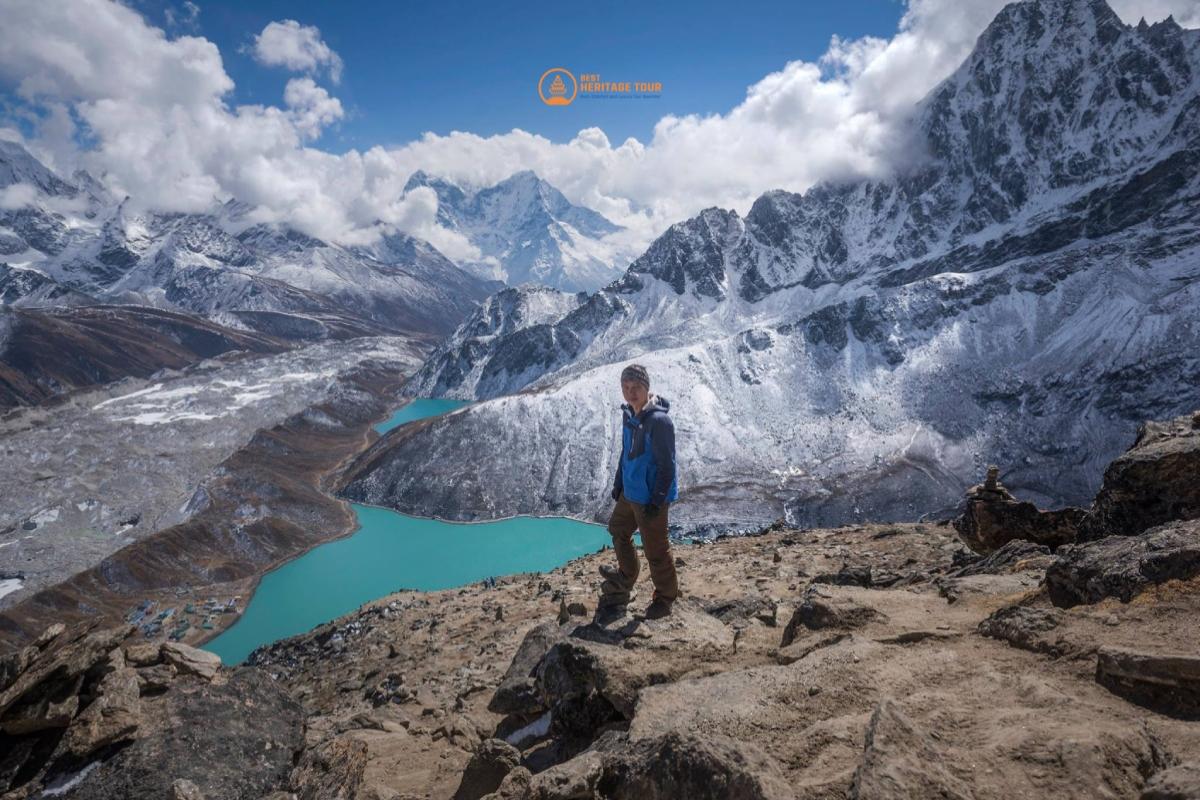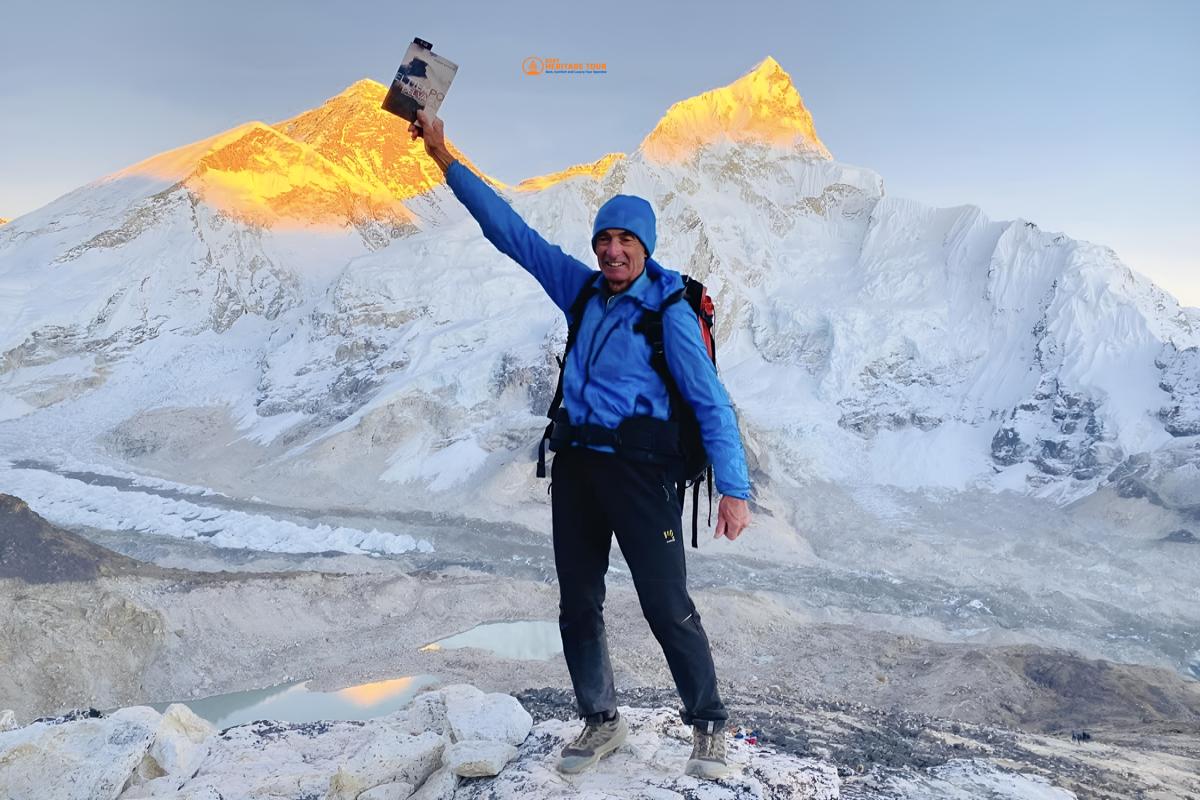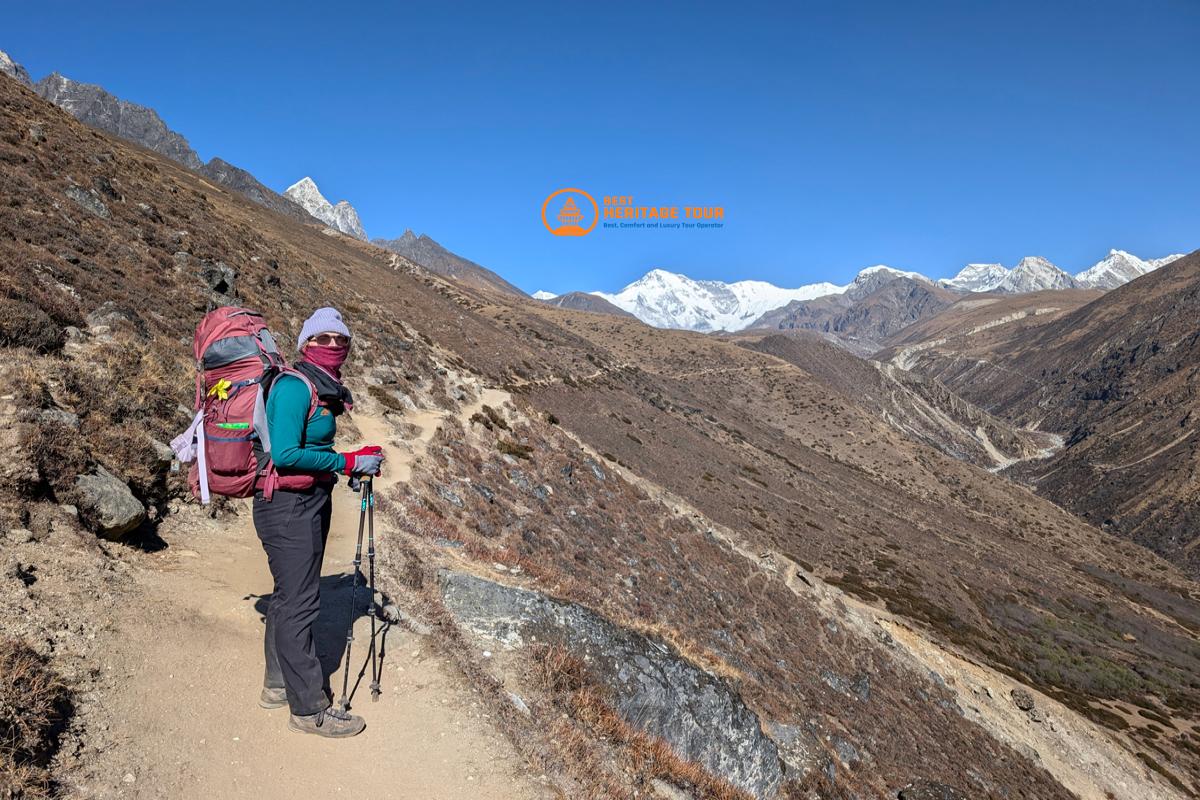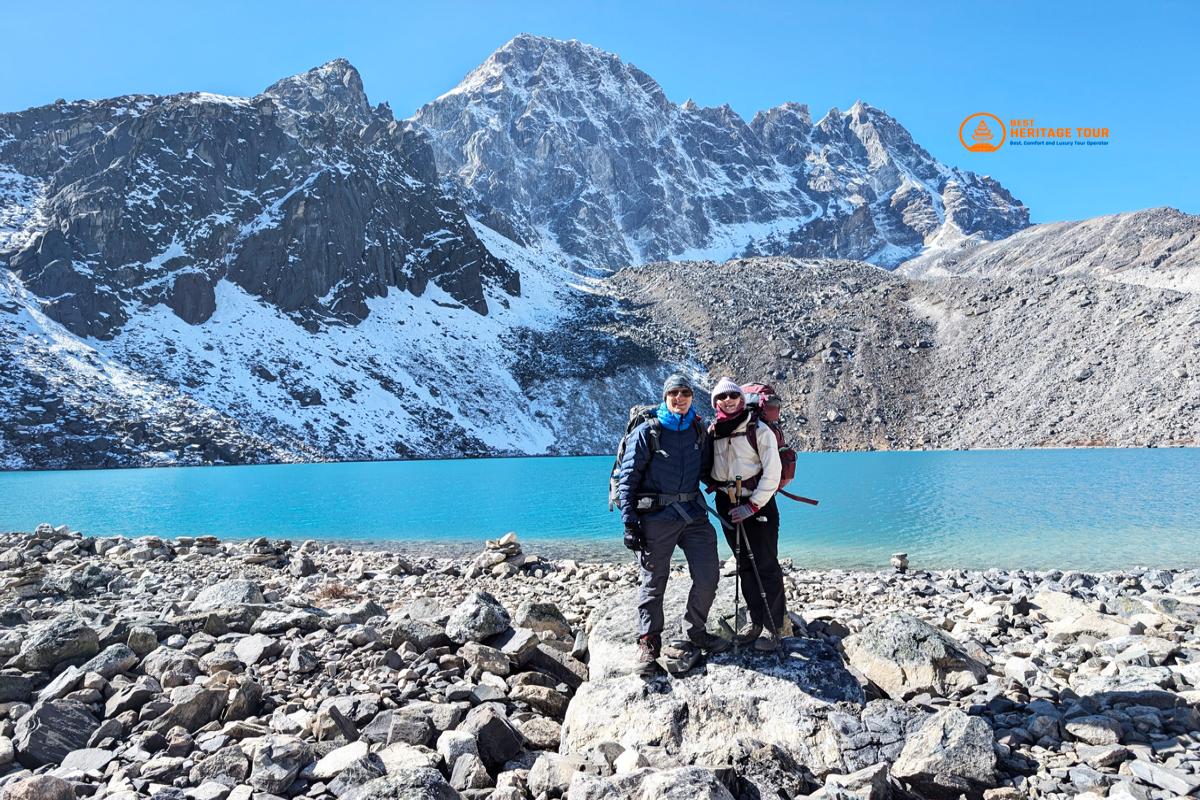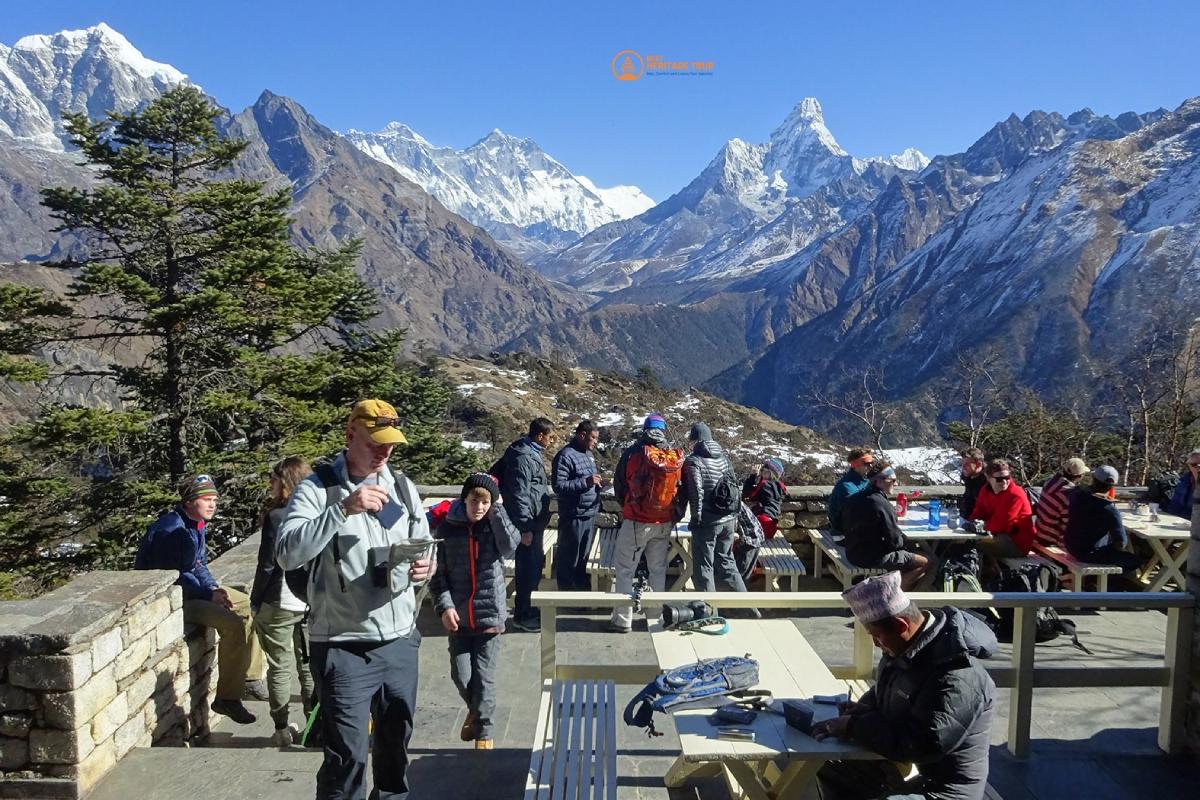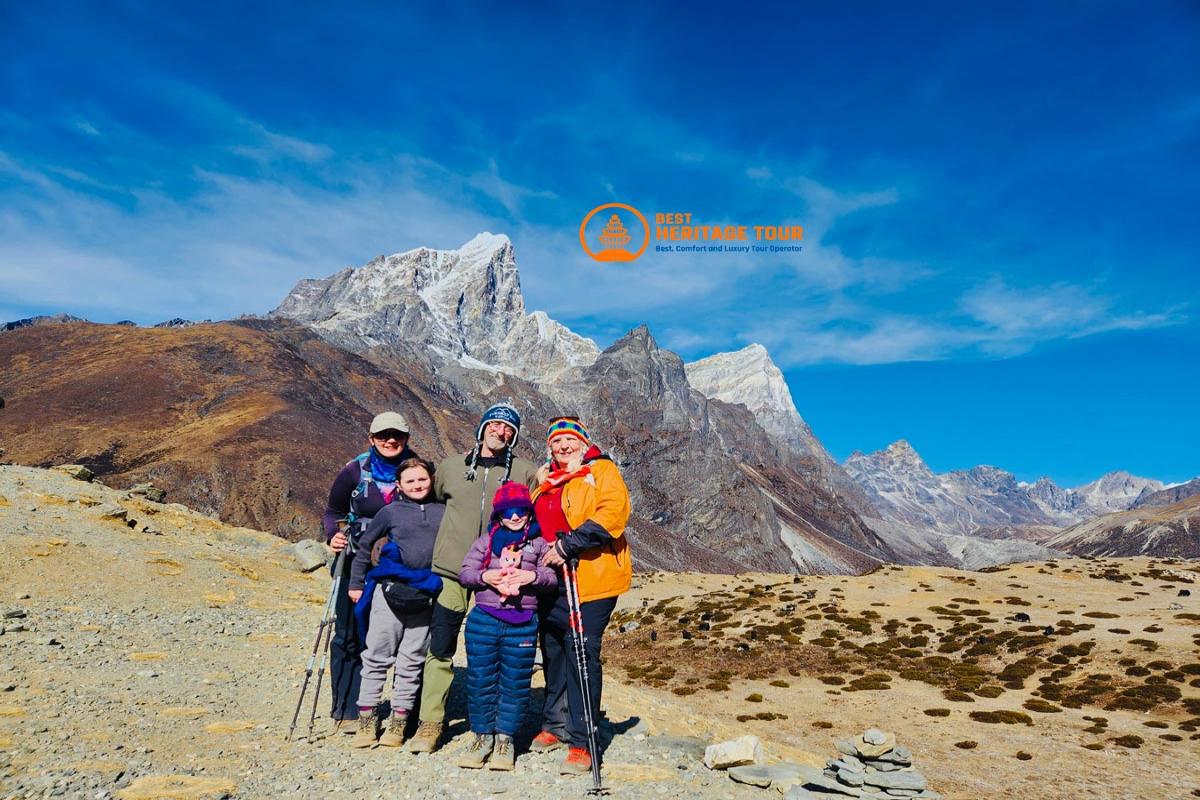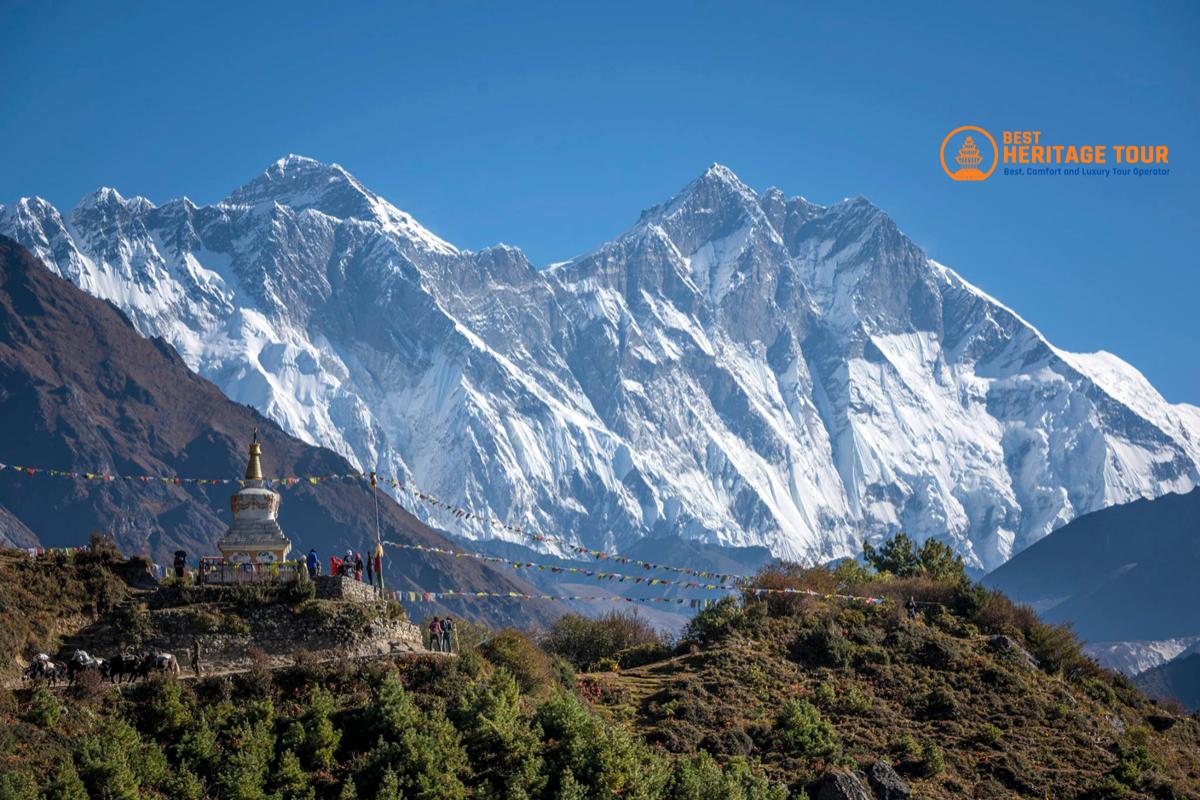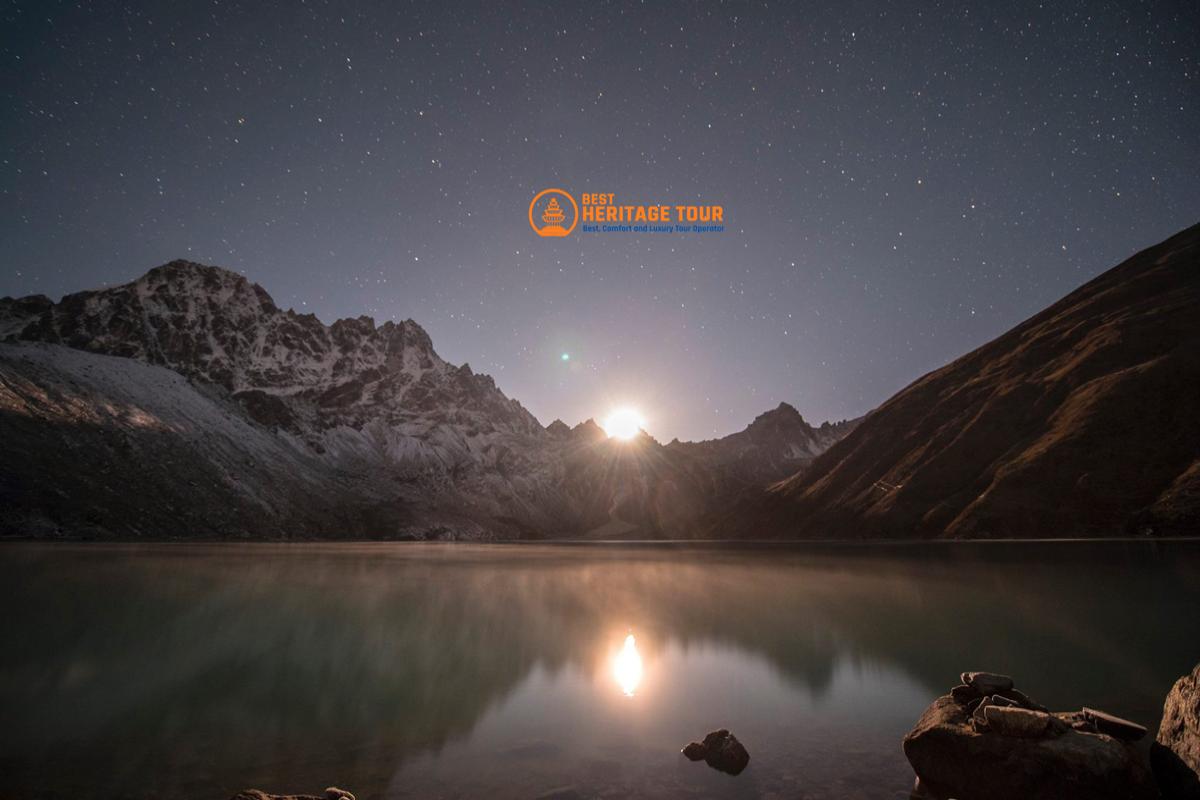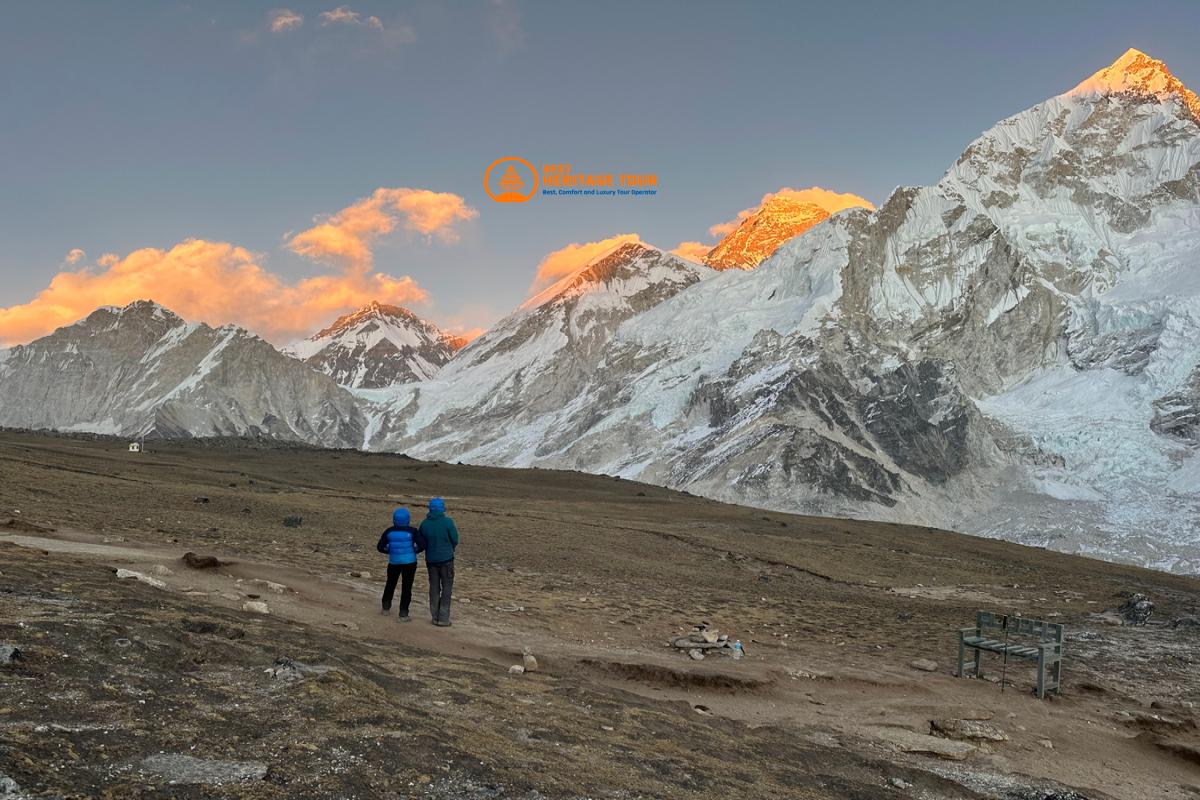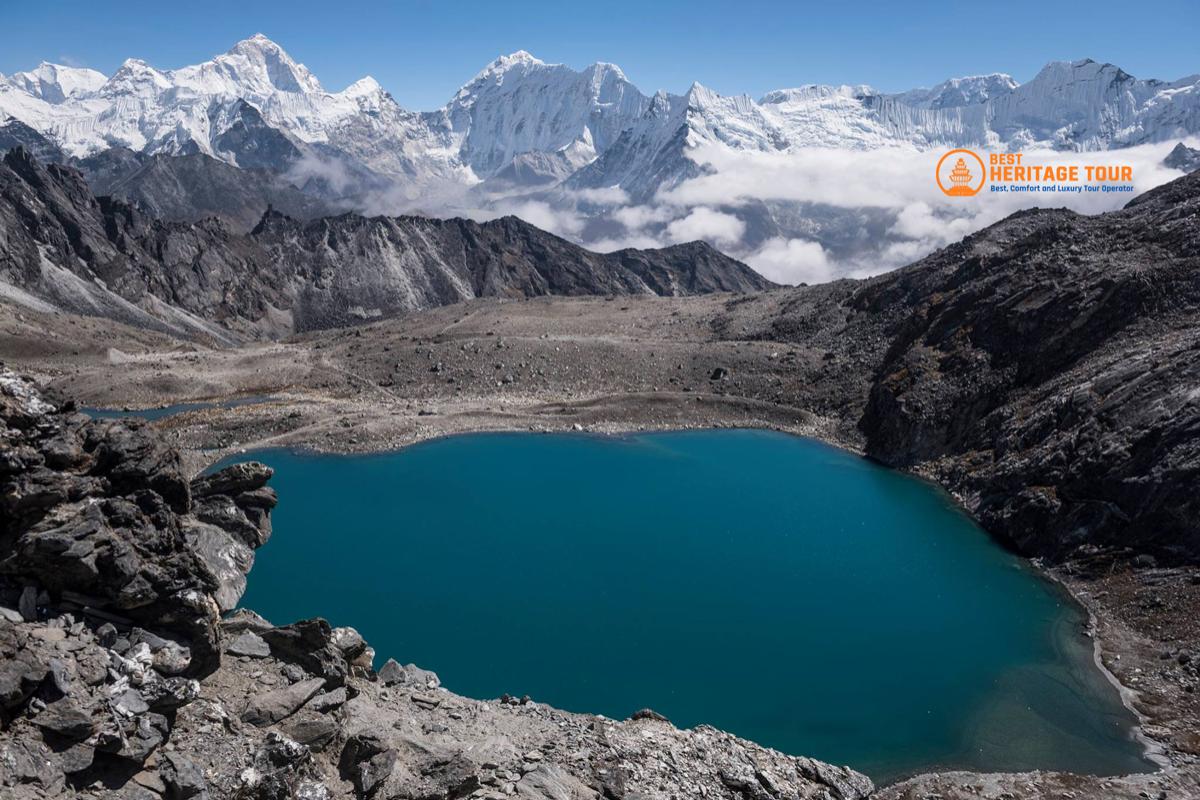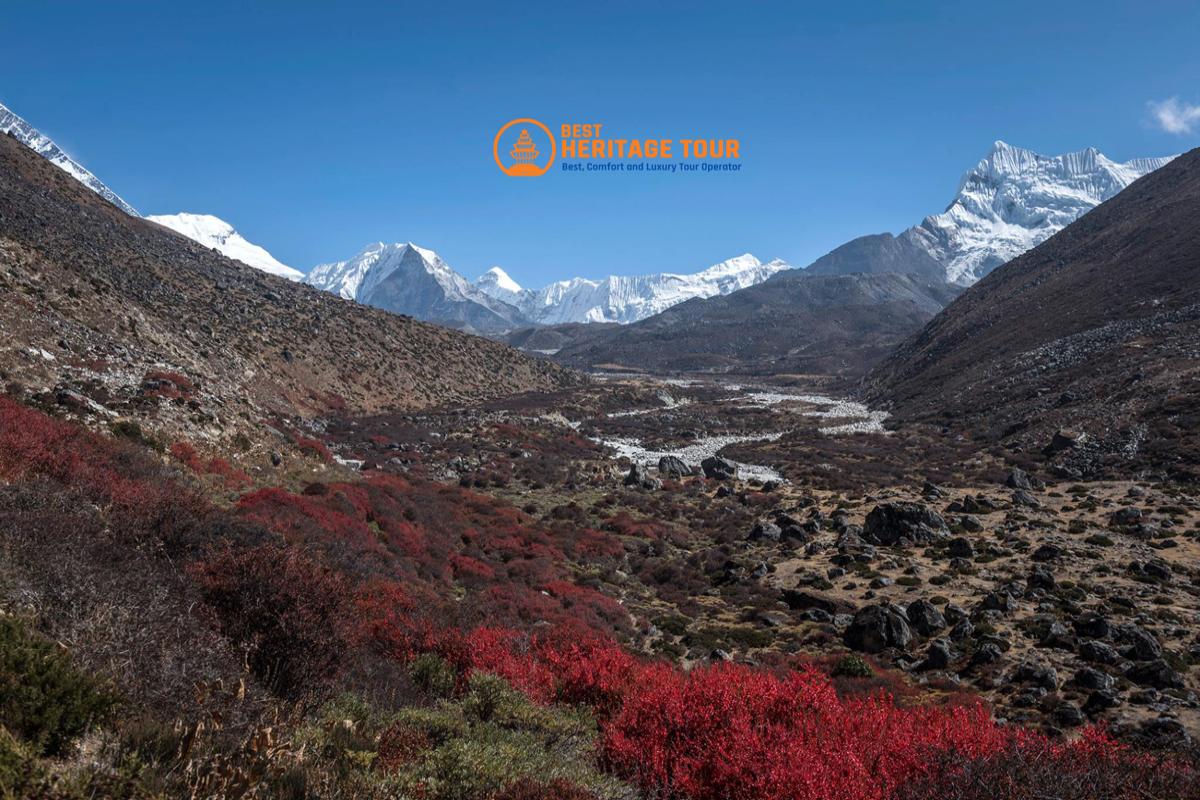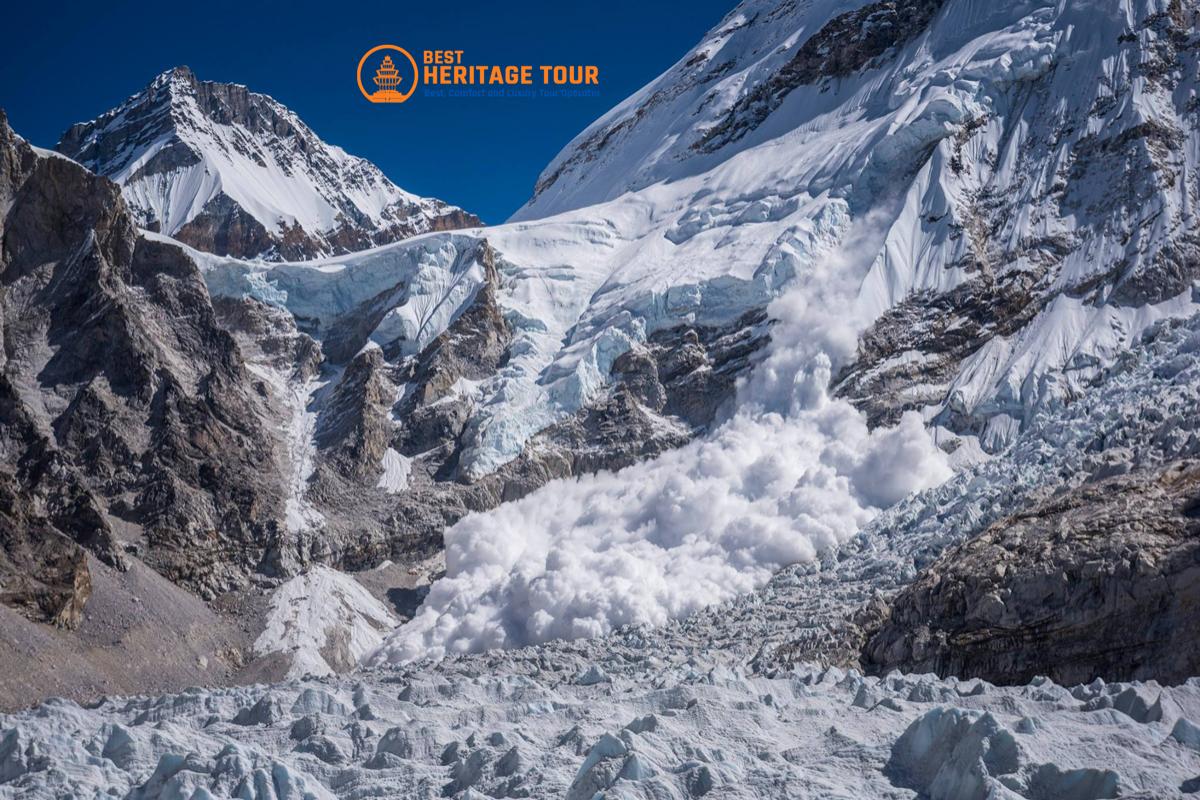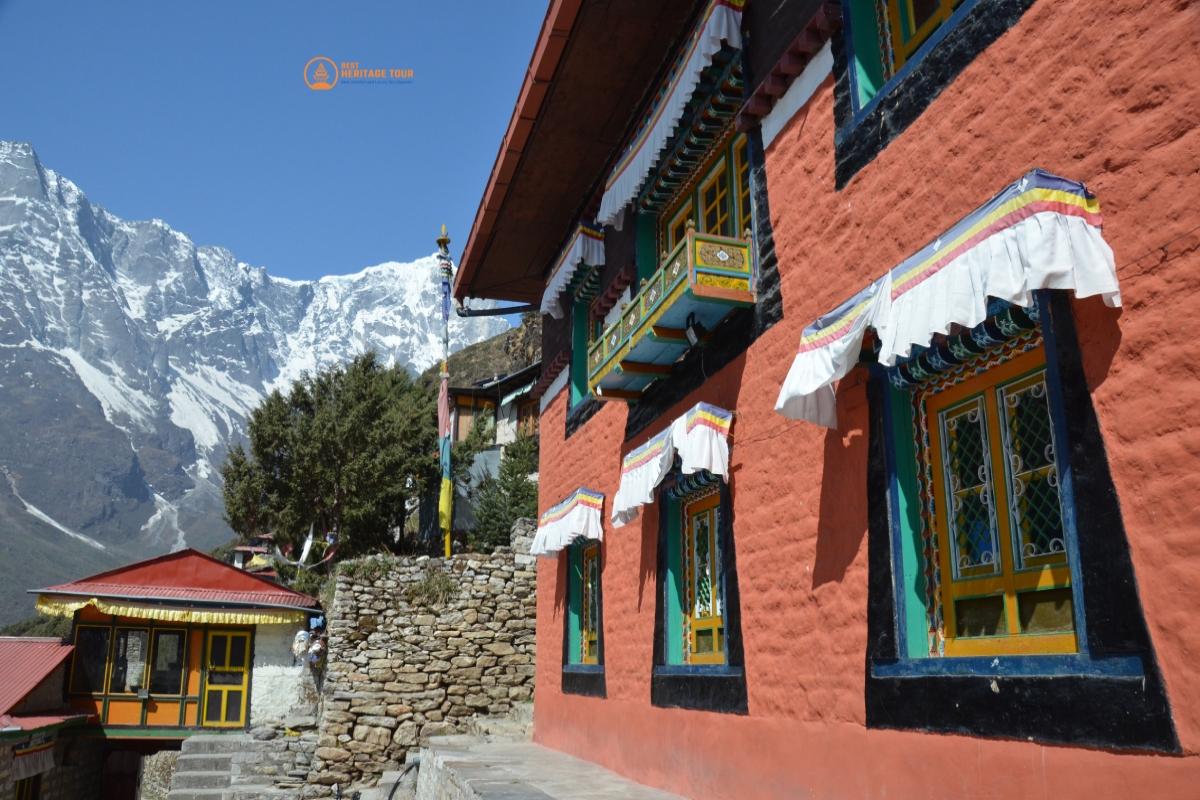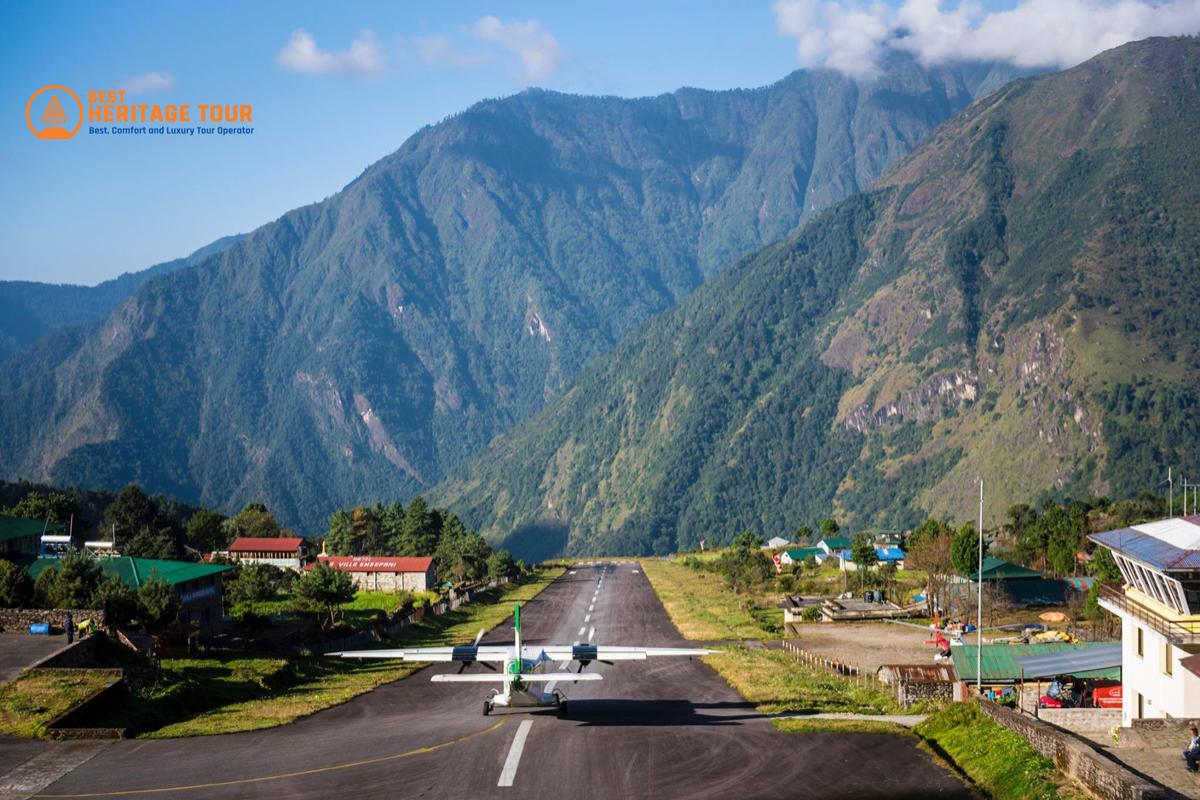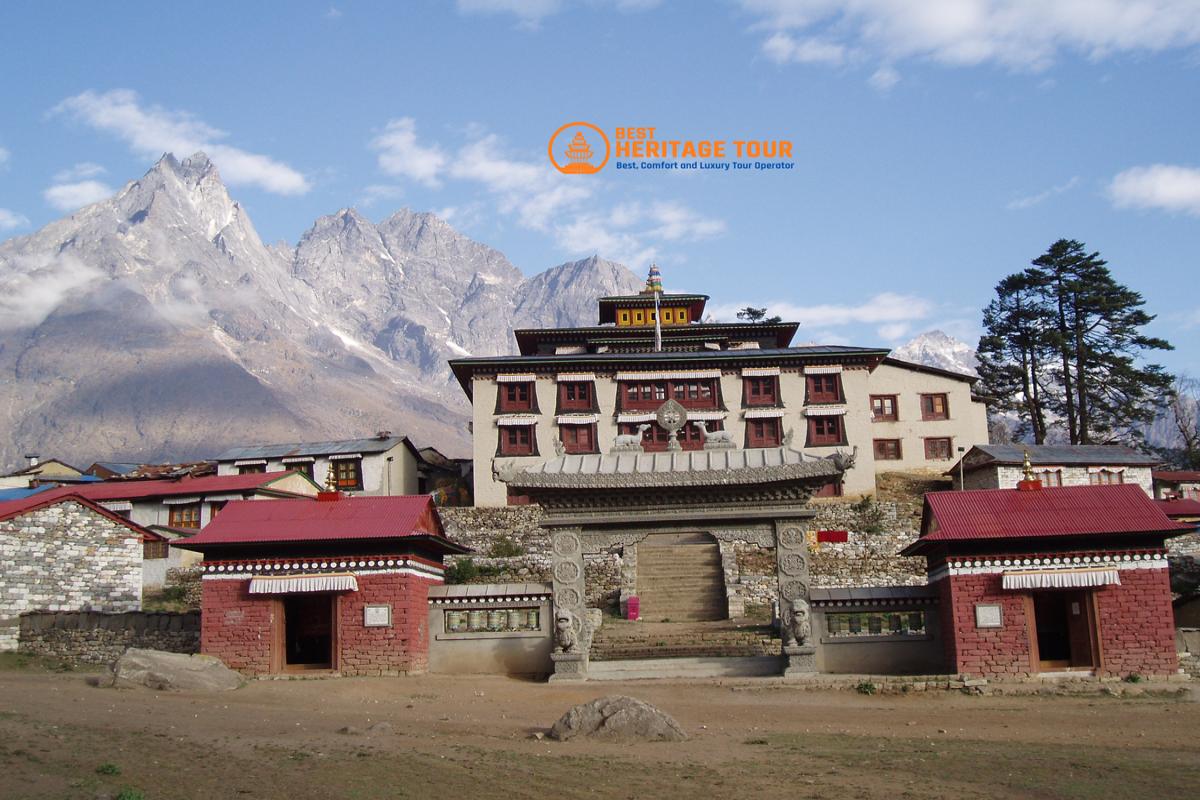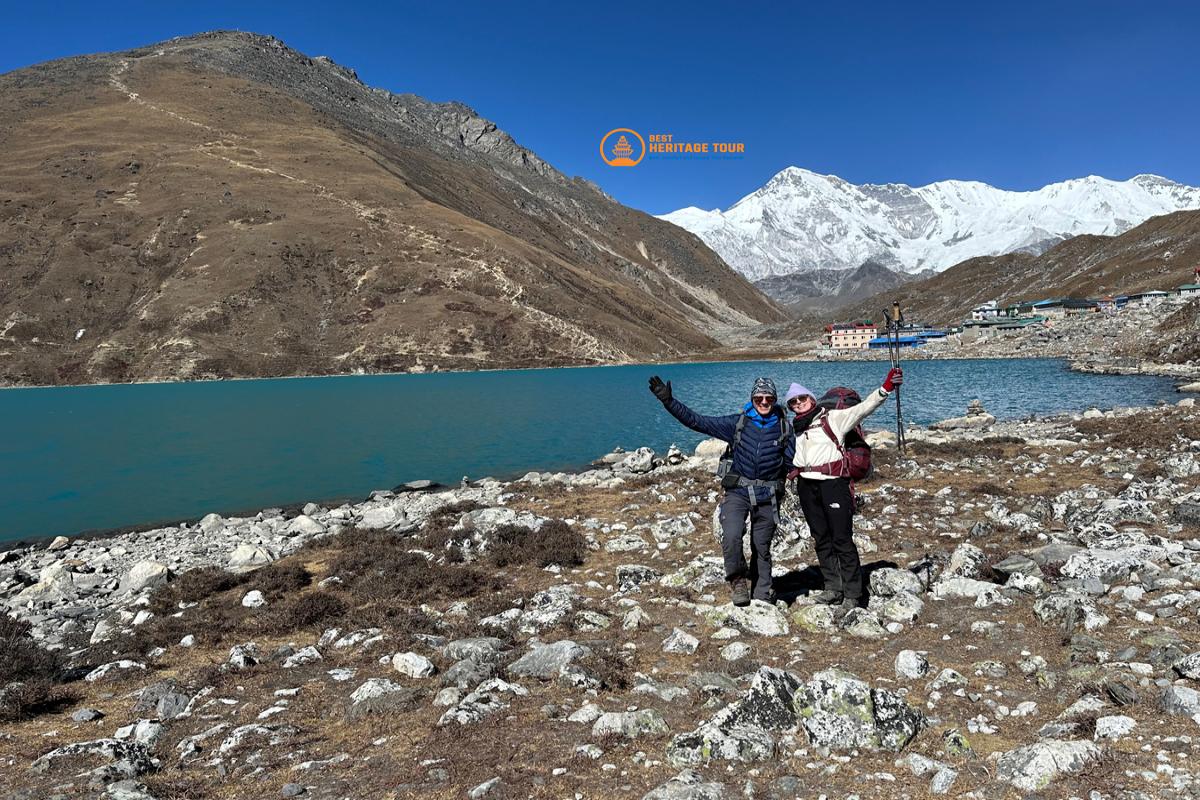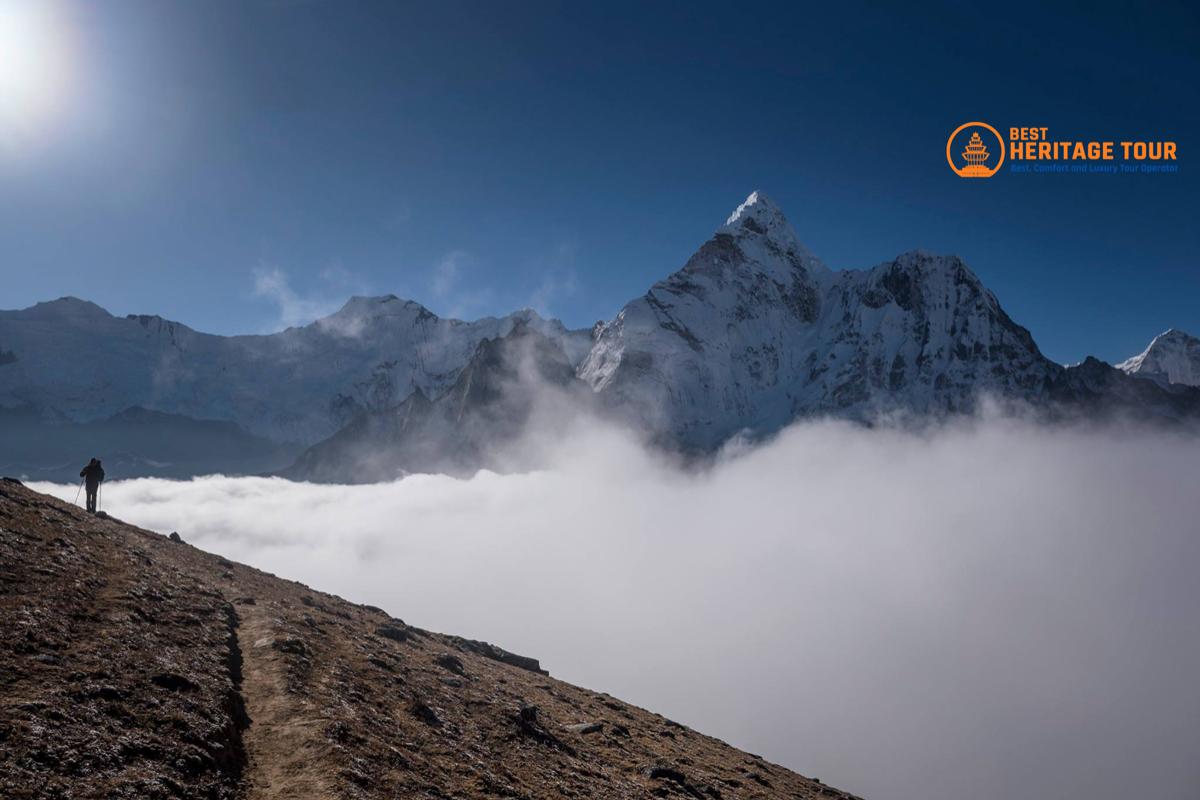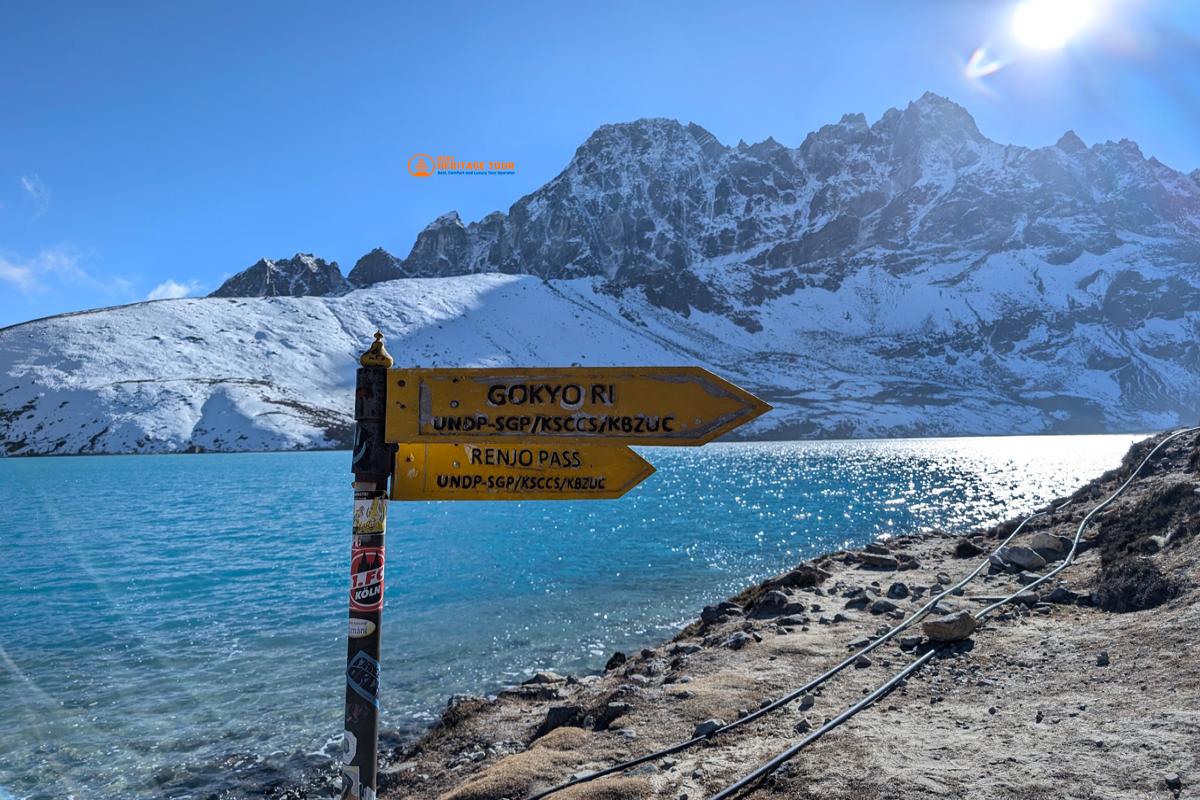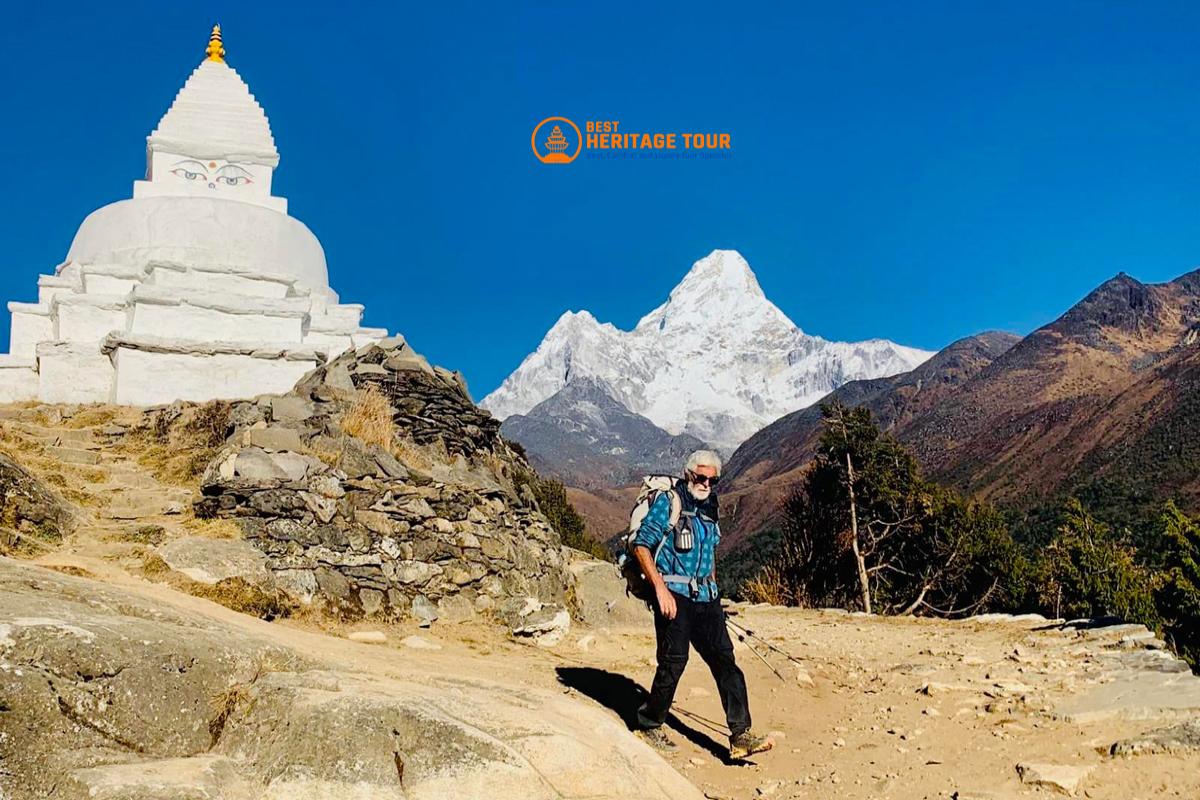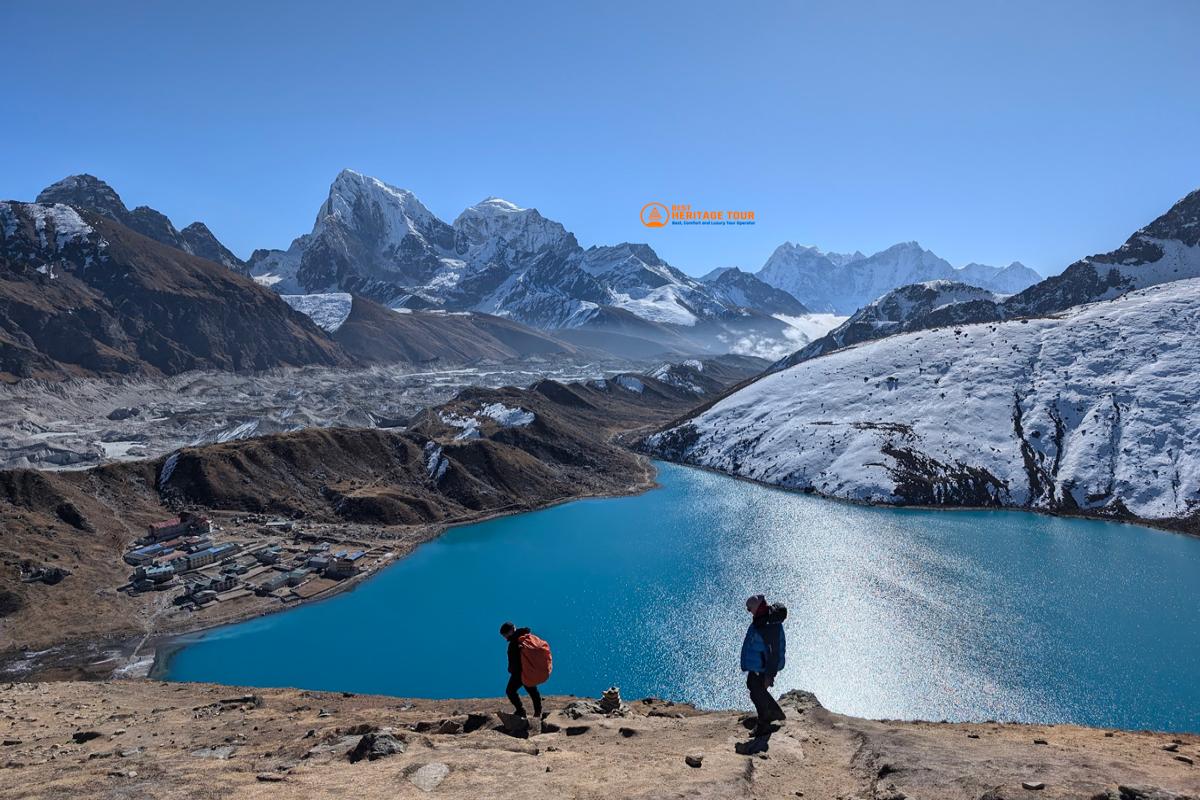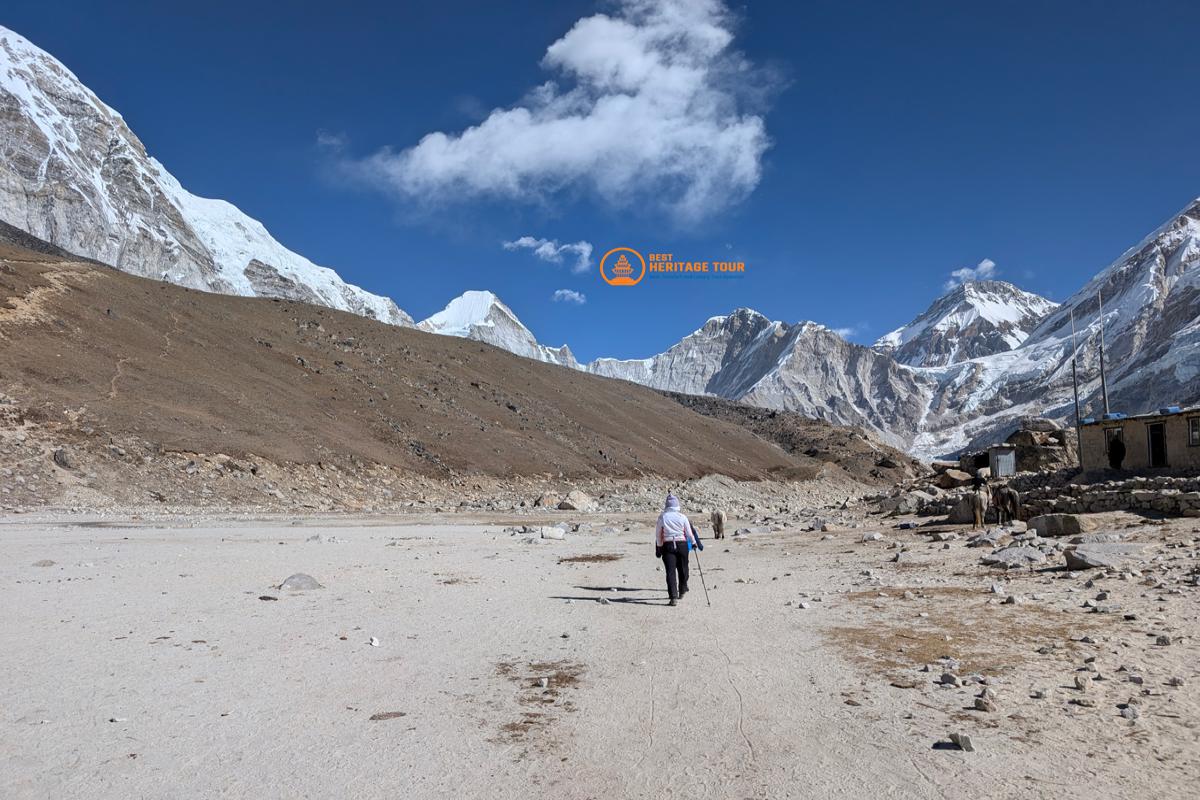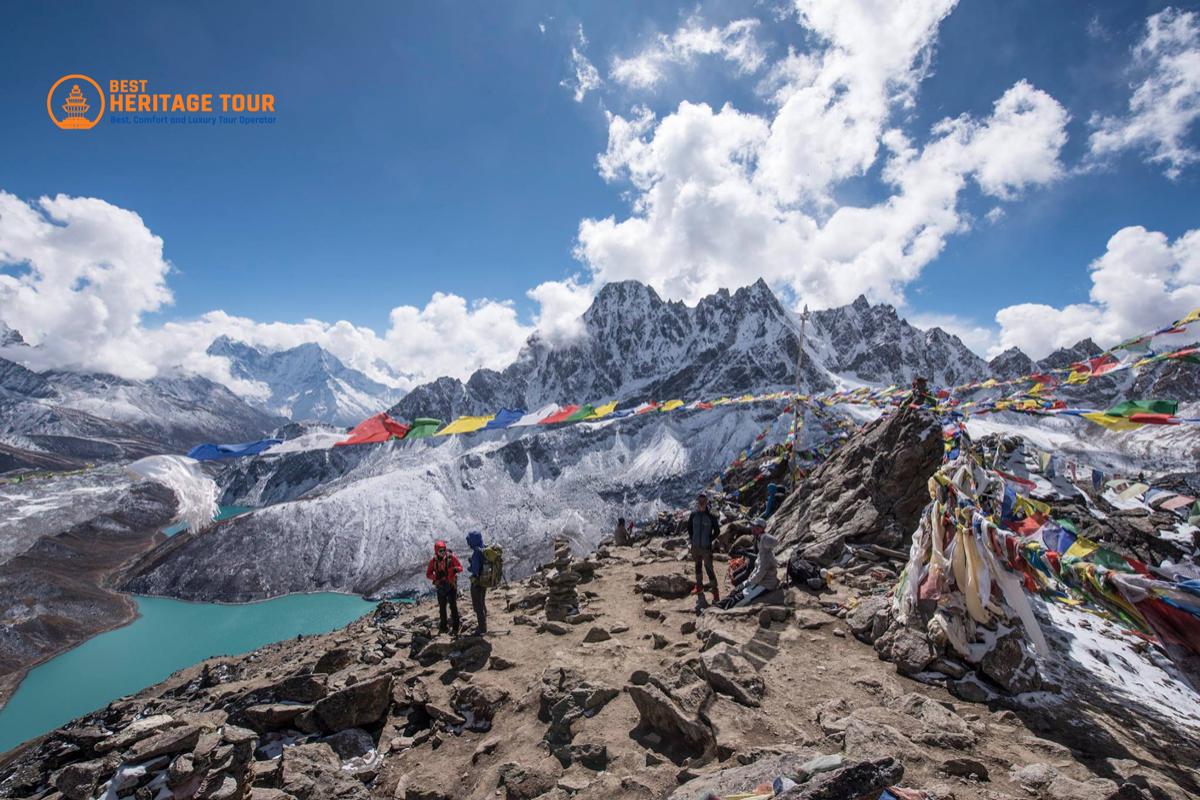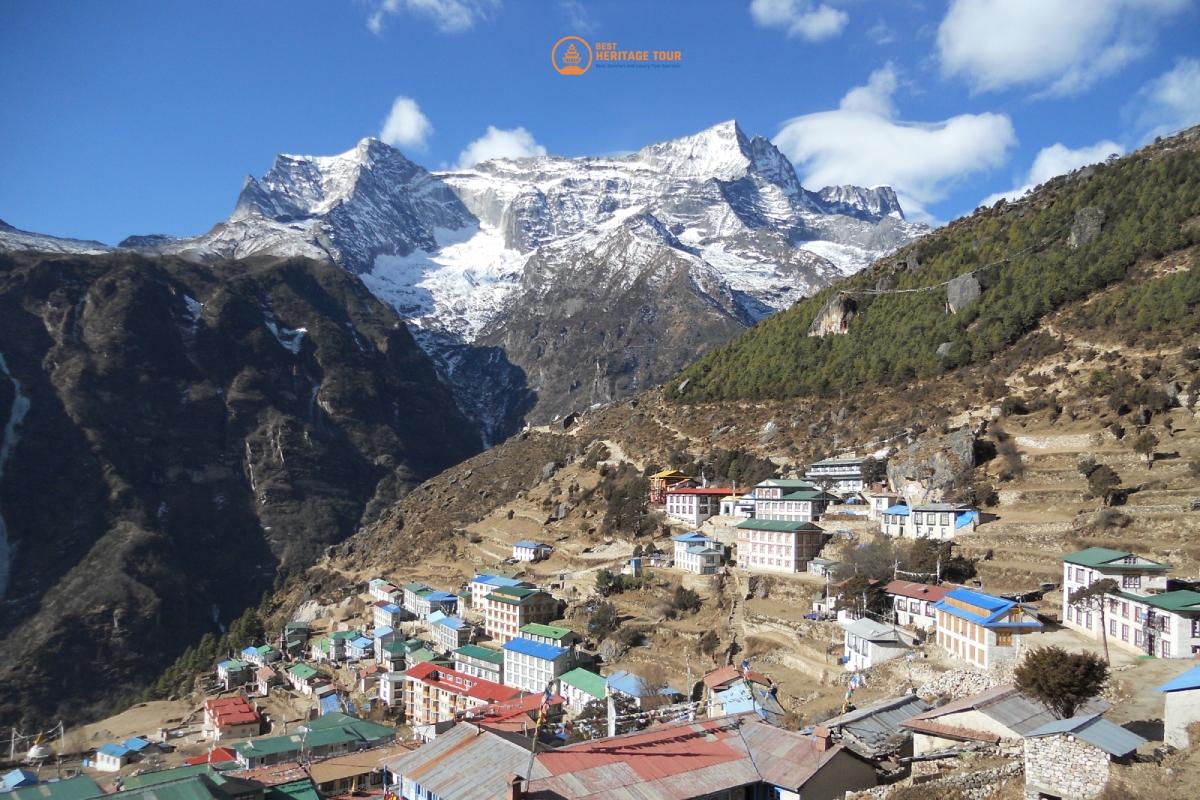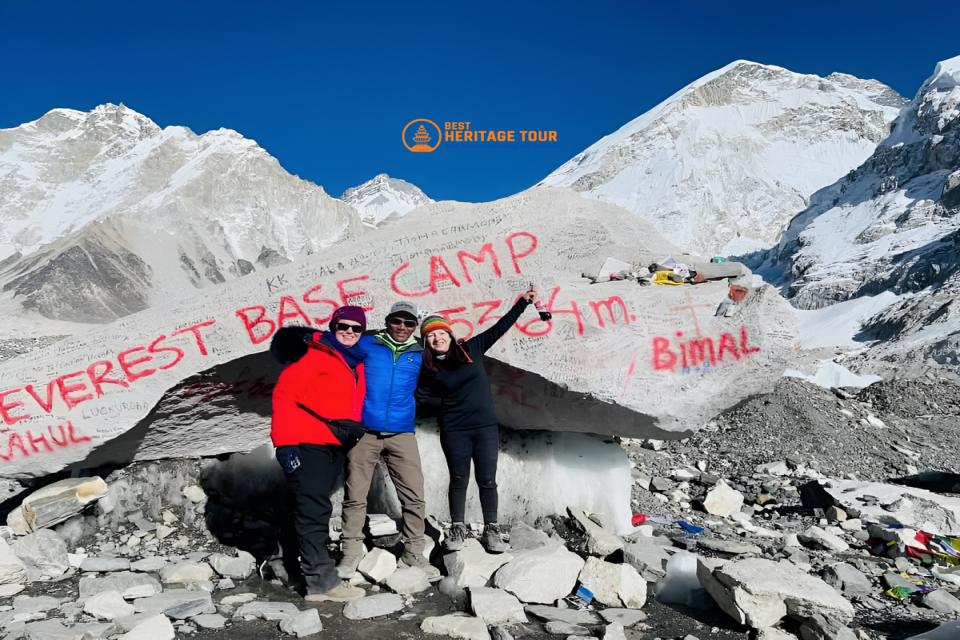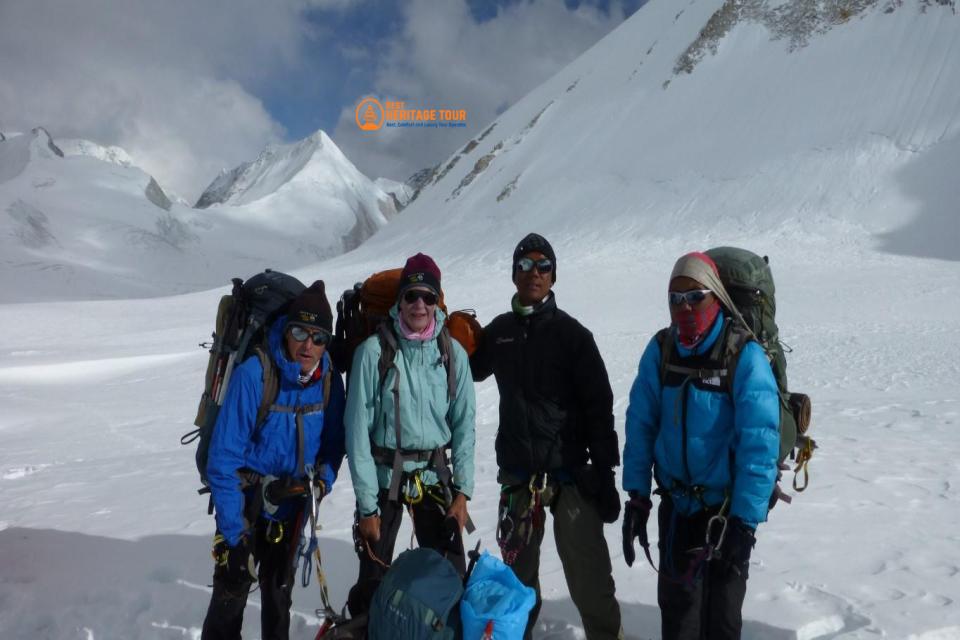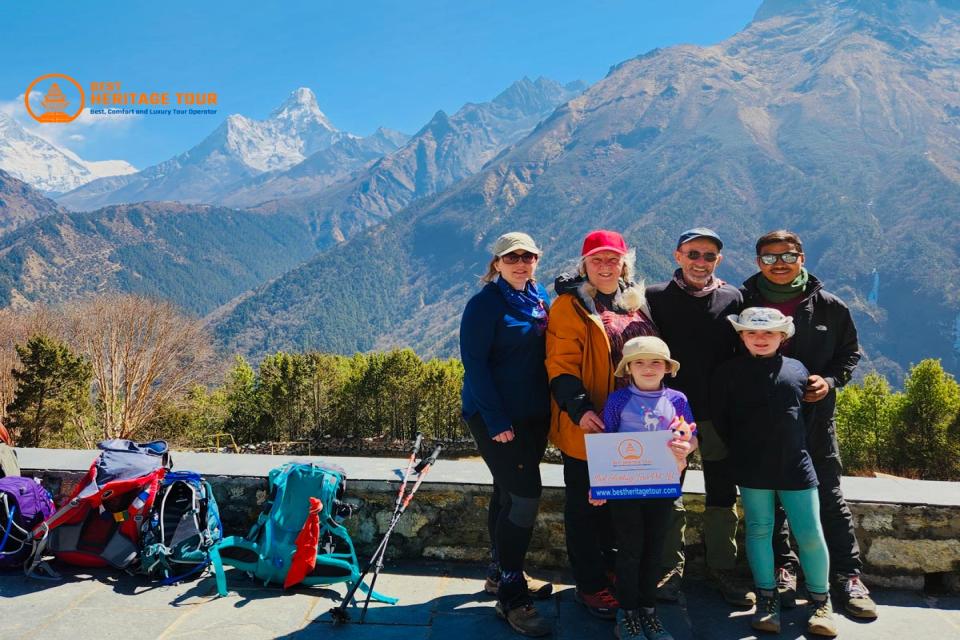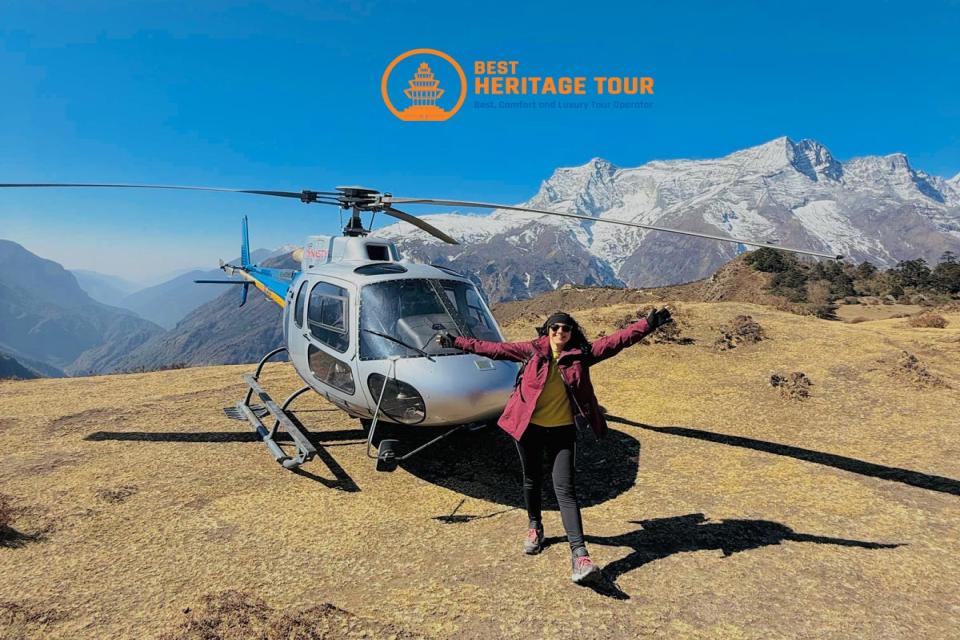Everest Base Camp Trek via Gokyo Lake - 15 Days
Insight on the Everest Base Camp Trek via Gokyo Lake
The Everest Base Camp trek via Gokyo Lake takes you deep into the Khumbu region, offering a chance to explore some of nature’s most spectacular treasures. Highlights include the serene Gokyo Lake, the challenging Cho La Pass, the panoramic Gokyo Ri Observatory, and the awe-inspiring Khumbu Icefall. Along the way, you’ll witness the world’s highest peaks, including Everest, Pumori, Lhotse, Cho Oyu, and Nuptse, while encountering unique high-altitude flora, fauna, and vibrant Sherpa communities.
Trip at a Glance
Key Features of the Everest Base Camp Trek via Gokyo Lake
- Scenic 40-minute flight from Kathmandu to Lukla and back
- Visit Namche Bazaar - the Sherpa capital
- Explore Sagarmatha National Park, a UNESCO World Heritage Site
- Marvel at the impressive Khumbu Icefall
- Enjoy panoramic views from Gokyo Ri (5,357 m)
- Discover the hidden Gokyo Valley, Gokyo Lake, and Cho La Pass (5,420 m)
- Experience local culture through prayer wheels, vibrant prayer flags, mani stones, and elevated suspension bridges
- Fly to the one of the highest airport in the world at Lukla
- Reach Everest Base Camp (5,364 m)
- Witness breathtaking views of mountains over 8,000 m, including Mount Everest (8,848 m)
- Learn about the region’s educational and medical facilities supported by Sir Edmund Hillary
Benefits of Everest Base Camp Trekking with Best Heritage Tours
- Easy booking and reservation system
- Online Travel Briefing after booking confirmation
- Diverse communication options available (email, WhatsApp, Facebook, WeChat, Viber, Skype, Zoom)
- 24/7 phone contact +977-9851149197/+9779810043046
- Simple payment system.
- Free airport transfer on arrival/departure to hotel by private vehicle
- Oximeter and other medical kits for monitoring blood oxygen at high altitudes for early detection of altitude sickness
- Sleeping bag and down jacket if you don't have one.
- Travel bag for porters
- Free excess baggage check at Best Heritage Tours store during the trek
Online Travel Briefing
The online briefing will clear all your doubts regarding the trek, including what to bring for the trek (Equipment checklist), itinerary details, precautions to take on the trail, etc. Once your booking is complete, you will be emailed the date and time available for your trekking meeting. Once we receive all the required documents, we will conduct your online trekking meeting.
Flight Information to Lukla
There may be slight changes to your trekking route, especially during peak trekking seasons (March, April, May, October, and November) as flights to Lukla depart from Ramechhap/Mantali instead of Kathmandu due to traffic congestion. At other times flights depart from Kathmandu. To catch a flight from Ramechhap, you will need to leave Kathmandu for Mantali at around 12:30 am on your scheduled departure date. The journey takes approximately 5 hours.
Trip Overview
Everest Base Camp via Lake Gokyo is a fascinating and adventurous hike that does not follow the classic Everest Base Camp trail. The hike is very challenging and circular, so you do not have to return the same way. This special trek does not follow the usual route to Everest Base Camp, so it is quiet, and peaceful and allows you to enjoy nature unhindered.
The trek starts from Lukla to Namche Bazaar, but like the classic Everest Base Camp trek, the trail branches off from Namche Bazaar. The route leads to two quaint towns, Dole and Machhermo, before arriving at Lake Gokyo in the northwest, rather than Syangboche. However, before reaching Dole, hike up to Mong La Pass (3,957 m). From there, you will be able to admire the magnificent views of the Ama Dablam and Khumbila mountain ranges. The road goes through pine and rhododendron forests.
Following an overnight stay in Dole Town, we proceed to Machhermo the subsequent day. The road is very gentle, and, on the way, we enjoy magnificent views of Mount Cho Oyu, the fifth-highest mountain in the world. Machhermo is a pasture and summer Sherpa village surrounded by snow-capped mountains.
The next day we leave Machhermo and head towards Lake Gokyo. There are five lakes in total, which are partially frozen even in March and April. Lake Gokyo is also home to golden Brahman ducks, which add more beauty to this already amazing place. Gokyo Valley also has villages, and as you climb, you will reach Gokyo Ri-One of the most famous viewpoints in the region. To enjoy the best views, you need to be at Gokyo Ri early in the morning to see the dawn.
We planned the seventh day as an acclimatization day, as we will be climbing at a significant altitude. Moreover, Gokyo Valley looks amazing, and you will need more than a day to enjoy the views and explore this tranquil area. On the eighth day, we drive to Thangnak and have to travel a distance of 3.7 km. The road is rocky, and uneven and has many ups and downs. On the way, we pass the Ngozumpa Glacier and several yak pastures. Finally, we reach Thangnak and spend the night there.
The next morning, we leave Thangnak early and head towards Cho La Pass This pass serves as a connection between the Gokyo area and the trail leading to Mount Everest Base Camp. Part of the path requires crossing the glacier itself. By the time you reach Cho La Pass you are over 2000 feet above sea level, but the route to Dzongla, your destination for the day, is easy as it is all downhill.
Your next hike starts from Dzongla, with Lobuche being your destination for the day. The journey is easy and leaves the remote parts of the trek behind as you return to the main route to Mount Everest Base Camp. You will follow the rugged Khumbu Glacier for a while. Our path also leads to monuments erected in memory of those who died in this harsh terrain.
Day 11 is special. This is the day you will set foot in Everest Base Camp, but to reach EBC you will have to trek from Lobuche through the moraine next to the Khumbu Glacier to Gorak Shep. Once you reach Gorak Shep, you will leave your bags in a hut and climb to Everest Base Camp. Assuming you will not be climbing to the summit, this is probably the closest you will get to Everest, the highest peak in the world. Reaching Everest Base Camp is a remarkable achievement, demanding significant physical and mental resilience. Every experience you gain along the way can change you, making you more determined and ambitious. You will spend the most unforgettable moments at the base camp of Mt. Everest, then descend to Gorak Shep to spend the night. However, you will have another chance to see the majestic Everest the next morning. Wake up early in Gorak Shep and go to the Kala Patthar lookout to witness the early morning sunlight shining on Everest and other Himalayan peaks.
The landscape looks surreal and takes you to a whole new world. It is a perfect place to take as many photos as you want. After spending some time at Kala Patthar, one will descend to Gorak Shep, enjoy breakfast, and then continue towards Pheriche. The hike takes about 5 hours, basically an easy walk, due to the loss in altitude. We stay overnight in Pheriche.
The next morning we leave Pheriche and head towards Namche Bazaar, which is even lower, but the path is not straight, and you have to climb a few meters in altitude. This day represents the penultimate stage of the trek, providing an opportunity to savor the final views of Mount Everest. Overnight in Namche Bazaar.
On the 14th day, wake up in Namche Bazaar and trek to Lukla. The journey is quite long, about 14 km. You will mainly trek through the Dudh Kosi River valley, crossing several suspension bridges and high forests. Rest for the night in Lukla It is likely to be your last evening in the Khumbu region.
If everything goes as planned, you will board your flight to Kathmandu after breakfast on day 15. We hope you have a comfortable flight and have the best memories during your hike.
We recommend our valued guests arrive in Kathmandu as early as possible, a day before the departure date, to prepare for the trek. This will allow time for a face-to-face meeting in case you miss the online trip meeting. It is advisable to add an extra 1-2 days to your trip in case your flight from Kathmandu to Lukla or back is delayed due to poor weather.
Itinerary
Your adventure to Everest Base Camp begins with a beautiful flight to Lukla. During the busy trekking months (March, April, May, September, October, and November), flights from Kathmandu to Lukla might be redirected to Manthali Airport. You will be picked up from your hotel around 12:30 AM to catch your early morning flight to Lukla and driven for 5 hours to Manthali, after which you will have a 20-minute flight to Lukla.
You can avoid the Kathmandu-Mantali-Lukla route by booking a direct helicopter from Kathmandu to Lukla. The cost is about USD 550 per person, shared among 5 travelers. Direct flights from Kathmandu to Lukla operate in December, January, February, June, July, and August. After breakfast, you will be transferred to Tribhuvan International Airport (TIA) for a 40-minute flight to Tenzing-Hillary Airport in Lukla.
After landing at Tenzing-Hillary Airport, your hike will begin. As today is the first day, the hike will be short, helping you acclimatize. The trail will take you through Chauriharka village down to Dudh Koshi, then continue to Phakding, your destination for the day. You can also use the extra time to explore Phakding's attractions, such as the Rimishung Monastery.
As you travel further north along the banks of the Dudh Kosi River, you'll be rewarded with magnificent views of the snow-capped mountains all around. You'll have to cross several suspension bridges, including the famous Hillary Suspension Bridge.
Going further, you'll reach Sagarmatha National Park, where you'll register your permit and ascend through dense forests, from where you'll get your first views of Mount Everest. However, you will continue hiking until you reach Namche Bazaar.
This day is entirely dedicated to acclimatization, the first day full of opportunities for different activities. Namche Bazaar is home to several cafes, restaurants, hotels, souvenir shops, and equipment stores with Wi-Fi.
Several other options include visiting the Sagarmatha National Park Visitor Center, a traditional Sherpa settlement, the Hillary School, a yak farm, and a Buddhist monastery.
After acclimatizing at Namche Bazaar, you hike to Dole, where your path diverges from the classic hike to Mount Everest Base Camp. The classic EBC hike continues to Tengboche, not Dole.
The road to Dol is rocky and has many ups and downs. After about 2 hours of hiking, you will reach Mong La Pass (3957m).
From this point, you will enjoy a fantastic view of Mt. Ama Dablam (6812m) and Mt. Khumbila (5761m). Continue downhill through dense pine and rhododendron forest to the riverside village of Phortse Tenga. However, you will continue moving until you reach Dole, your destination for the day.
As you leave Dole and climb further, you will reach a beautiful meadow used as a yak pasture, next to which you will see some shrines and prayer flags. During summer, these pastures are green, and you can see yaks grazing there. But in winter, this area becomes barren, and locals also migrate to this area to escape the harsh winters.
Ahead, you will see the breathtaking Mt. Cho Oyu, the fifth-highest mountain in the world. The road then passes through La Palma village, then Ruja, before finally reaching your destination in Machhermo.
Today is a day to visit the Gokyo Lakes. After an hour of hiking, you cross high meadows to reach Phanga, where you can see a memorial to those who lost their lives in the landslide.
As you continue your journey, the trails get narrower, leading you to the first Gokyo Lake, the smallest of the five main Gokyo lakes. A short walk from the third Gokyo Lake brings you to Gokyo village, one of the highest villages in Nepal. In the heart of the Gokyo Valley, you can spot the famous Gokyo Ri viewpoint up the hill.
Day 7 is designated as the acclimatization day in Gokyo, during which you will have the opportunity to explore the Gokyo Valley. However, you will not miss reaching the famous Gokyo-Ri Viewpoint (5,430 m / 17,519 ft). From here you can see four of the six highest peaks in the world: Everest (8,848m), Lhotse (8,516m), Makalu (8,485m), and Cho Oyu (8,188m). We will also visit other Gokyo lakes.
After a day of acclimatization in Gokyo village, you continue your trek. Your destination for this day is Thangnak. On the way, you will pass the Ngozumpa Glacier. The trail itself has a lot of ups and downs, but it is short and there is no elevation gain.
Located in a tranquil setting on the edge of the Ngozumpa Glacier, Thangnak village is an ideal base for hikers aiming to reach the Cho-La High Pass (5,330 m).
After a night at Thangnak, you will hike early in the morning over rocky paths and glacial deposits to reach the top of Chola Pass. After a few hours of hiking, you will reach the top of Chola Pass and be rewarded with a stunning view of Chola Lake and Mount Cholatse (6,440 m).
As you descend, the path will become icy and slippery. The views you will enjoy on this hike are very beautiful. After about 7 hours of hiking, you will reach Dzongla, your destination for the day. It's a fairly long hike.
On day 10, you'll leave Dzongla and follow the sediments down along Cho Lak Lake. Then you'll follow the Khumbu Glacier. Along the way, you'll see a memorial to climbers who died in the region.
Unlike the previous day, the hike to Lobuche should be pleasant. Before reaching Lobuche, follow Imja Khola. After about 4 hours of trekking, you will reach Lobuche, which is your destination for the day. Once you reach Lobuche, you will return to the classic hiking trail to the base camp of Mount Everest.
This day will be a great day for you as you will reach the base camp of Mount Everest. However, the journey starts from Lobuche and gets steeper as you get closer to Gorak Shep. Once you reach Gorak Shep, leave your bags there and head towards Everest Base Camp. When you reach Everest Base Camp (EBC), you will feel a sense of accomplishment as if all your efforts have paid off.
Achieving EBC requires continuous physical effort and a lot of determination. Therefore, a journey to EBC will make you a better person in some way. The view from EBC is amazing and you will have the opportunity to enjoy the view of Khumbu Glacier. It is advisable to capture numerous photographs that will serve as cherished memories for a lifetime.
After enjoying the view from EBC, you will hike to Gorakh Shep and spend the night there but rest assured that another great day is waiting for you.
You rise early in the morning from Gorak Shep and hike to Kala Patthar to see the sunrise over Everest. The views you will experience are unlike anything you have ever seen before.
After spending some time at Kala Patthar Viewpoint, you descend to Gorak Shep to have breakfast and rest for some time. You then head to Pheriche, your destination for the day.
Today, wake up in Pheriche and head to Namche Bazaar. The trail passes through forests where you can see wildlife such as pheasants, musk deer, and mountain goats.
Along the way, you will see many prayer flags and chortens, but this is your last chance to see Everest. Continue hiking and reach Namche Bazaar where you will spend the night.
Like all great experiences, this one must end. Today is your last day on the trail. After breakfast, you will hike up a steep path, cross the Hillary Suspension Bridge, and pass through several villages. You spend most of the hike in the Dudh Kosi River Valley and the surrounding area.
Upon arrival in Lukla, refresh and relax in your hotel. This is likely your final night in the Khumbu region. You have succeeded despite many adversities. It's a moment worth celebrating.
If everything goes as planned, you will return to Kathmandu by early morning flight. The flight path from Lukla varies with the trekking season. If the trek takes place in March, April, May, September, October, or November, you will most likely fly to Mantali, and we will drive you from Mantali to Kathmandu. In other months (December, January, February, June, July, and August), there are direct flights from Lukla to Kathmandu. If you prefer to skip the Lukla-Mantali-Kathmandu route, you can arrange a helicopter. Assuming 5 people share the cost, it will cost you around USD 550 per person (extra).
We hope that your return to Kathmandu will be truly relaxing. You are probably thinking about your trip to Everest Base Camp and feeling a bit excited to soon see your loved ones back home. Best Heritage Tours will arrange a farewell dinner in Kathmandu later that day.
What is included?
- Domestic flight (Kathmandu - Lukla - Kathmandu), air tickets, departure tax
- Total of 14 nights (5 nights - Lukla, Phakding, Namche (3 nights), rooms with private bathroom; 9 nights - Dole, Machhermo, Gokyo (2 nights), standard rooms in Thangnak, Dzongla, Lobuche, Gorak Shep, Pheriche)
- All meals during the trek (15 lunches, 14 dinners, 15 breakfasts)
- Government-certified experienced English-speaking Best Heritage Tours trekking guide and porters to help hikers carry their luggage (1 porter per 2 hikers, weight limit of maximum 25 kg)
- Guide and porter fees, meals, insurance, salary, accommodation, transportation, airfare, necessary equipment
- Water purification tablets for safe drinking.
- Entry fees to Sagarmatha National Park
- Khumbu pasang lhamu rural municipality fees.
- Assistance to organize rescue measures in case of a medical emergency (funded by travel insurance)
- Souvenir - Best Heritage Tour T-shirt and Purse
- Certificate of Best Heritage Tours after a successful Trek
- Farewell dinner after finishing the trek
What is not included?
- International flight ticket
- Visa fee upon arrival at Tribhuvan International Airport (15 days: $25-30, 30 days: $40-50, 90 days: $100-110).
- Excess baggage charges during the trip
- All accommodation and meals in Kathmandu before and after the trip
- Additional overnight stay in Kathmandu due to early arrival, late departure, or early return from the trek.
- Personal expenses (groceries, snacks, boiled/bottled water, hot (tea, coffee) and cold drinks, hot showers, alcohol, Wi-Fi, calls, battery charging charges), additional carriers, etc.
- Personal clothing and equipment
- Travel insurance with mandatory coverage for emergency rescue and height evacuation
- Gratuities to guides and porters (Recommended)
- Extra expenses due to delays beyond our control. For example, landslides, weather conditions, changes in travel routes due to safety concerns, illness, changes in government policies, strikes, etc.
- Are there any additional costs not listed in Itinerary & Included Section
- All government taxes 13%, SSF, and 10% service charges
Route Map
Equipment
Head
-
Sun hat or scarf
-
Winter hat, warm hat, or broad-brimmed hat
-
Headlamp with extra batteries
Face
-
Sunscreen
-
Sunglasses with UV protection
-
Face/body wipes
Hands
-
Lightweight gloves
-
Thick winter gloves
Body
-
Hiking shirt
-
Long-sleeved shirt
-
Rain jacket with hood
-
Fleece jacket
-
Lightweight cotton pants
-
T-shirt (bring a light woolen one)
-
Polypropylene underwear
-
Down jacket (rent in Kathmandu)
-
Sweater
-
Waterproof jacket and pants
Footwear
-
Hiking shoes
-
Thick woolen socks (bring an extra pair of thick, lightweight socks)
Essential Equipment
-
Backpack or daypack (size depends on whether you bring a carrier or not).
-
Thermos flask
-
Water treatment
-
Trekking poles
-
Sleeping bag (-15 bag is best for high altitude hiking)
Bathroom Amenities
-
Medium-sized dry towel
-
Toothbrush
-
Toothpaste
-
Deodorant dental floss
-
Biodegradable soap
-
Nail clippers
-
Small mirror
Personal Accessories
-
Money
-
Watch
-
Cell phone
-
Camera
Extra Items
-
First aid kit
-
Extra passport photo and passport copy
-
Notebook and pen
-
Binoculars
Trip Info
Arrival
Best Heritage Tours offers all our guests on Everest Base Camp trekking via Lake Gokyo a free transfer from the airport to your hotel on arrival and a free transfer from your hotel to the airport on departure. Our representative will come to Tribhuvan International Airport with a pamphlet with your name on it. As a welcoming gesture, he will give you a garland or kada and then take you to your hotel. We offer this service, so you do not get in trouble in a foreign country.
Trekking Start
You must arrive in Kathmandu at least one day before your trekking departure date by 3 pm. This will give you time to attend a final meeting to ensure you have everything you need for the trek. On the day of your trek, we will pick you up from your hotel and take you to Tribhuvan International Airport for your flight to Lukla. The flight time is approximately 40 minutes. After arriving in Lukla, on your first day, you will hike to Phakding.
A Typical Day
Every day you will enjoy a unique trekking experience, including climbing, enjoying the scenery, taking photos, and exploring the surrounding villages. Our trekking guides will provide you with information about the places you will visit. Our porters will handle most of your bags. However, you may need a backpack to carry your valuables and essentials.
A typical day starts with an early breakfast. You will then start today's trek at around 7-8 am depending on the duration and trail conditions. After 3-4 hours of hiking, it's time for lunch. After lunch, you will rest for 1 hour before setting off again. The afternoon trek is usually shorter and should take 2-3 hours. Upon reaching your overnight destination, you will eat additional diet food and explore the surrounding places until dinner. After dinner, there will be time for socializing. Your trekking guide will also inform you about the plan for the next day.
Before going to sleep, enjoy a game of Monopoly or cards, a mountaineering documentary or a book. If you would like to learn some general Nepali words, our staff will be happy to teach you.
Electricity and Water
All lodges on the way to Everest Base Camp via Lake Gokyo have electricity and you can charge your camera and mobile phone there. Please note that this service might come with a charge. During the trek, you can purchase packaged mineral water at local lodges and shops along the route or have boiled water filled into bottles for an additional fee. BHT supplies water purification tablets to ensure the water is safe to drink. We strongly recommend not drinking water from local rivers, taps, and fountains as it may not be safe to drink.
Communication
Internet service is available at lodges/hotels for a small fee. But once you reach high altitudes communication is by phone. Depending on the type of network, even if you can get a signal, it may not be strong enough at high altitudes. You can also purchase a local SIM card for a reliable connection. We communicate with our valued guests through our trekking guides at least once a day to ensure that all our guests are safe and comfortable.
Wi-Fi service is available in all lodges/hotels on the route but may be subject to charges.
End of the Trek
On the morning of the 15th, you will head to Lukla to catch your flight back to Kathmandu. The feeling of having finished the trek and reached the end of the trail will leave you feeling relaxed during the flight. The flight will take around 40 minutes. Spend some time in Kathmandu at your leisure. We will organize a farewell dinner in Kathmandu in the late evening.
Useful information
We recommend that you plan 2 extra days for your trek, as Lukla airport is very busy during the trekking season and your flight may be postponed. We will provide tips to help you avoid missing your international return flight. You can also book a helicopter, but the cost will be between $500 and $1,000.
Please note that the above itinerary is only a general guide. In rare cases, adjustments to your itinerary may be necessary due to circumstances beyond your control, such as Landslides or bad weather.
Trip Extension
If you would like to stay in Nepal for a few more days after the trip ends, you have several options. You can explore Kathmandu and its surrounding areas, go on a jungle safari in Chitwan, or visit Pokhara. You can also enjoy paragliding, rafting, canoeing, and more.
Trekking Season
Weather is a key factor for a successful trekking tour to Everest Base Camp. Unfortunately, weather forecasts are unreliable, and the weather can change quickly at high altitudes. But still, trekking experts, adventure seekers, and locals visit Everest Base Camp all year round. For most of us, the best season is spring or autumn when the skies are clear, and the mountain range offers amazing views. Best Heritage Tours offers EBC trekking tours all year round.
In winter, the trekking becomes difficult due to snow and rain during the monsoon, but some people still look forward to the trek.
Please note that the weather in the Himalayas is very unpredictable and temperatures change quickly.
Difficulty of the Trek
This level of travel is challenging but worth it. The trek is at high altitude so you must be able to walk at a good pace on a route with multiple ascents and descents. However, if you are in normal health, you can complete this trek. No prior knowledge is required. You may need to prepare yourself physically by doing aerobic exercises such as jogging or swimming. Remember, the more fit you are, the more you will enjoy the trek. If you are not in good health, you may need to prepare earlier. If you suffer from any serious medical condition, such as heart, lung or blood disorders, you should consult a doctor before booking a trek.
Trekking Safety
Best Heritage Tours ensures a safe and comfortable trek. Our trekking packages include an acclimatization day. We offer all necessary travel items, including a first aid kit. Moreover, our tour guides have undergone extensive first-aid training. Your blood oxygen saturation will be tested at altitude. In case of serious illness, your trekking guide will decide whether to continue the trek or descend immediately.
In case of emergency, we will use a helicopter to return you from the high altitude. Furthermore, we travel in groups to keep everyone safe.
Visa
A visa is required for all foreign nationals, with the exception of Indian citizens, to enter Nepal. Most nationals can obtain a visa on arrival at Tribhuvan International Airport. For visa details, please check https://www.immigration.gov.np/.
To apply for a visa, you must provide a passport that is valid for a minimum of six months along with a passport-sized photograph. The visa costs $50 for 30 days and can be paid in cash when you arrive at Tribhuvan International Airport.
Nationals of China and SAARC countries receive a free visa. Nationals of Nigeria, Ghana, Zimbabwe, Swaziland, Cameroon, Somalia, Liberia, Ethiopia, Iraq, Palestine, and Afghanistan may not be able to obtain a visa on arrival and should contact their Nepalese embassy.
Trekking Booking
Best Heritage Tour is a government-approved trekking and tour company. We are proud members of the Nepal Trekking Agencies Association (TAAN) and the Nepal Mountaineering Association (NMA), so you can book our services with confidence.
To secure your booking, a 10% deposit is needed. After booking, other required documents such as passport copy, passport photo, travel insurance policy, and arrival and departure details are required. Please send these documents within one week of booking. You can pay by bank transfer, Western Union, or direct online payment through our website. The remaining trip fee can be paid upon arrival in Nepal by cash, bank transfer, or credit card. We will also send you the payment details via email.
Money Exchange
The local currency is the Nepalese Rupee (NPR/Rs). Most foreign currencies can be exchanged at local banks and reputable exchange offices throughout Kathmandu and Thamel. The currency exchange rates gets changed on frequently, so do not forget to check it. Generally, exchange offices will show their exchange rates clearly. We recommend bringing cash with you to exchange to avoid lengthy procedures and expensive bank fees.
You can withdraw cash (in rupees only) from ATMs, which are numerous in Kathmandu and Thamel itself. Most ATMs are available 24/7. If you use a foreign card, you can withdraw up to 35,000 rupees with a fee of 500 rupees. Using the currency exchange services of banks and financial institutions can charge a fee of 4% or more. There are no banks or currency exchange services in the trekking area, so you will need to exchange money in Kathmandu. You cannot use foreign money in markets around the Everest area.
- Most Asian banks will not accept old, torn, or faded foreign currency notes. Please bring clean notes only.
Additional Personal Expenses
This package covers most things during the trek, but not everything. Food and accommodation in Kathmandu are at your own expense. All types of accommodation are available depending on your budget. Similarly, you will need additional money for visa procedures, purchasing travel insurance, drinks (including alcohol, hot (tea, coffee) or cold drinks), tips for crew, souvenirs, etc.
It is advisable to bring major currency and exchange it in Kathmandu. Markets in the trekking area only accept Nepalese Rupees.
Travel Insurance
This trip is challenging as it is at a high altitude and there is a risk of altitude sickness and other unforeseen circumstances due to sudden weather changes. Travel insurance is mandatory for the Everest Base Camp trek via Gokyo Lake. All trekkers must provide Best Heritage Tours with a copy of a comprehensive travel insurance policy.
Your insurance must cover medical and emergency repatriation, including helicopter rescue and evacuation costs at high altitudes (up to 6000 meters). We can refer you to insurance companies that may help based on our customer experience, but we do not sell insurance. BHT reserves the right to reject trekkers if their travel insurance policy is insufficient, inappropriate, or missing.
Trekkers will be asked to submit detailed insurance information after booking the trek. This will help us to organize a fast and effective rescue operation in case of an emergency.
Notice: Before taking out travel insurance (don't just take the information from the website), call your insurance company and check if they cover helicopter rescue and evacuation up to 5,500m altitude.
Last minute bookings
If you are unable to book in advance, Best Heritage Tours still accepts last-minute bookings. To avail last last-minute bookings, full payment must be made 24 hours before the departure date. However, please note that although we will do our best to always accommodate walks, in case of last-minute bookings we cannot be held responsible for delays due to events beyond our control such as Bad Weather or lodge availability.
For more details, please reach us at +977-9810043046 or 9851149197 or email us at info@bestheritagetour.com.
Group and Private Treks
We organize both group and private trekss. Group discounts are given depending on the size of your team. The bigger the team, the more discount you will receive. However, if Best Heritage Tours organizes your group, they will not be eligible for any discounts. We can accommodate groups of any size. Each group will have one group leader, one porter for every two trekkers, and one assistant guide for groups of 12 or more.
Ecotourism
As a responsible trekking and travel company, we understand the importance of ecology. If we do not protect our trekking areas now, no one will come to them in the future. That is why we work with the Kathmandu Environmental Education Project (KEEP) to organize ecotours that meet the expectations of trekker and residents.
Quick Note:
Our trekking packages have fixed departure dates, but please check your dates and let us know if it does not suit you. We can tailor a trek to suit your needs.
We are excited to guide you through the beautiful Gokyo Lake region to Everest Base Camp.
Review
Trekking Gokyo Lakes and EBC
Bimal from Best Heritage Tours had his office in the Hotel we stayed in in Kathmandu, and he offered to help us plan our trek. He was really open about what options we had in the...
View DetailPerfectly Organized EBC trek via Gokyo Lake by Best Heritage Tour
I recently finished my Gokyo Lake Trek with the Best Heritage Tour. And they did an excellent job organizing everything perfectly. The itinerary was perfect for us with...
View Detailbeautiful night with first butter tea experience
The Everest Base Camp via Gokyo Lake trek was a lifetime memory. The Gokyo valley had its own charm, culture and it was peaceful and more beautiful compared to classic EBC...
View DetailHighly Recommended Trekking Company
Best Heritage Tour has handled everything well from the first inquiry right up to the last day in Kathmandu. The team's experience, kindness, and professionalism made a huge...
View DetailUnforgettable EBC trek with Best Heritage Tour
My nephew and I did EBC via Gokyo Lakes together. It was the great experience with Best Heritage Tour. Everything was well organized and smooth from the very beginning. The BHT...
View DetailMountains, Monasteries and Memories
I wanted to do something different and I chose the Gokyo Lake trek. This trek did not disappoint me. The views were outstanding at the every moment along the trek. The trek was...
View DetailA dream came true with Best Heritage Tour team
Since I was a child, I always dreamed of seeing Everest with my own eyes. Trekking through the Gokyo Lake route was even better than I imagined. The lakes, snow-capped Himalayas...
View DetailExcellent trek and the best team
The Best Heritage Tour team was simply outstanding. We loved to trek with them. Sadan Gurung was our guide, who always had a positive attitude with friendly nature. He was highly...
View DetailFAQ's
This trek offers breathtaking views of the Everest region, including the stunning Gokyo Lakes. It combines the classic trek to Everest Base Camp with a detour to Gokyo, renowned for its serene glacial lakes and spectacular mountain views.
The package typically includes guided trekking, accommodation, meals during the trek, necessary permits (TIMS and national park entry), and a comprehensive pre-trek briefing. Airport transfers and some sightseeing in Kathmandu may also be included.
The Everest Base Camp Trek via Gokyo Lake is considered moderate to challenging due to the high altitude and varying terrain. Trekkers should prepare for tough uphill and downhill trails.
Along the trek, you'll encounter Sherpa villages, ancient monasteries, and local customs. Opportunities to learn about the culture, participate in local festivals, and interact with communities are plentiful.
The best times are pre-monsoon (March to May) and post-monsoon (September to November), when weather conditions are more stable and views are clearer.
Temperatures can vary significantly. In spring, daytime temperatures range from 10°C to 15°C (50°F to 59°F) at lower altitudes, but can drop to -10°C (14°F) or lower at night in higher altitudes.
Generally, temperature decreases as altitude increases. Expect cooler temperatures at higher elevations, with possible snowfall at Base Camp and Gokyo during certain times of the year.
Dress in layers. Begin with moisture-wicking base layers, then incorporate an insulating layer such as fleece, and complete your outfit with a waterproof outer layer. Don’t forget warm gloves, hats, and thermal socks.
Most nationalities are eligible for a visa upon arrival at Tribhuvan International Airport in Kathmandu. Ensure you have a valid passport, passport-sized photos, and the necessary fee (which varies by duration).
Fly to Kathmandu, where you can arrange your trek logistics, obtain your TIMS (Trekkers’ Information Management System) card, and any necessary permits.
Tourist visas can be issued for 15, 30, or 90 days. Extensions can be arranged at the Department of Immigration located in Kathmandu.
Payments can usually be made through bank transfers, credit cards, or cash (in USD or local currency). It’s advisable to confirm the accepted payment methods with your trekking agency.
Yes, expect additional costs for meals not included in the package, travel insurance, tips for guides and porters, and any optional activities like sightseeing in Kathmandu.
Additional costs can include personal snacks, drinks, tips for guides and porters, optional excursions (like helicopter flights), and extra accommodation in Kathmandu before or after the trek.
While having prior trekking experience is beneficial, it is not a requirement. Basic fitness levels and determination to walk for several hours daily are essential.
Yes, the trek is accessible for beginners who are in good health and willing to acclimatize to higher altitudes.
Accommodation ranges from tea houses in lower regions to more basic lodges in higher areas. Most provide comfortable beds and meals.
Hot showers may be available for an additional fee in many tea houses, especially in larger settlements.
Essential items include trekking boots, warm clothing, a sleeping bag, water purification tablets, trekking poles, and a first-aid kit. A comprehensive packing list will be made available upon confirmation of your booking.
Essential gear includes a good-quality sleeping bag (rated for cold temperatures), trekking poles, a headlamp, a hydration system or water bottles, and sunscreen.
Yes, it’s advisable to use lightweight, breathable clothing and good-quality trekking boots. Wearing multiple layers is essential for easily adapting to varying temperatures.
Tea houses generally provide basic amenities, including a bed, shared bathrooms, and dining areas. Some may offer Wi-Fi and charging facilities for an additional fee.
Trekkers should be in good physical condition. Regular cardiovascular exercise (like hiking, running, or cycling) in the weeks leading up to the trek is recommended.
Acclimatization is crucial. Gradual ascent during the trek and staying hydrated can help mitigate altitude sickness. Consult a doctor for advice on medication if necessary.
It is recommended to engage in regular cardiovascular workouts, strength training, and to practice hiking while carrying a weighted backpack. Aim for hikes that simulate the altitude and distance of your trek.
It is prudent to seek advice from a healthcare professional prior to the trek, ensure you receive any necessary vaccinations, and bring along a basic first-aid kit.
Yes, comprehensive travel insurance covering trekking, altitude sickness, and emergency evacuation is mandatory.
It’s advisable to get vaccinated against hepatitis A and B, typhoid, and tetanus. Consult with a travel health clinic for personalized advice.
Many tea houses offer charging facilities, usually for a fee. However, it's wise to carry a power bank for convenience.
ATMs are available in larger towns like Namche Bazaar, but it’s best to carry cash, as they may not always be reliable.
Tap water should not be consumed. It's best to use water purification tablets or buy bottled water from reliable sources.
Numerous tea houses provide Wi-Fi access, although the connection may be slow. Satellite phones are also available for rent in Kathmandu for emergencies.
The trek usually starts from Lukla, which you can reach via a short domestic flight from Kathmandu.
In case of cancellations due to weather, you may need to wait a day or take a helicopter if available. Flexibility in your schedule is important.
The flight time from Kathmandu to Lukla is roughly 30 to 40 minutes.
Yes, all our guides are fluent in English and many speak other languages. This facilitates clear communication and enhances your overall experience.
Most trekking guides in Nepal speak basic to advanced English, which is enough for general communication about trekking and safety precautions. Some speak more fluent English, which will improve your overall trekking experience.
Yes, most visitors need a tourist visa to enter Nepal. A visa can be obtained on arrival at Tribhuvan International Airport in Kathmandu or applied for in advance at a Nepalese embassy or consulate.
Yes, you will need two passport-sized photos for both the visa application and the trekking permits, so it's a good idea to bring extra copies just in case.
You'll need a valid passport (with at least six months validity), a passport-sized photo, and the visa fee (which varies depending on the duration of stay).
To obtain the RAP, you’ll need:
- A valid passport.
- A Nepal visa.
- Travel insurance.
- Two passport-sized photos.
- A letter from your trekking agency detailing your itinerary and the names of the guide and group.
Yes, it’s possible to extend your visa if you wish to stay longer in Nepal. Extensions can be processed at the Department of Immigration in Kathmandu or Pokhara, but you should apply before your current visa expires.
You can exchange US dollars or Euros for Nepalese rupees upon arrival, but we recommend carrying cash in the local currency for most transactions outside of major cities.
Facilities may vary, but most teahouses offer the following:
- Basic bedding (mattress, pillow).
- A dining area for eating meals.
- Charging options for electronic devices (usually for a fee).
- Limited Wi-Fi access.
Yes, teahouses are generally safe and many hikers have had good experiences with them, but it's wise to use common sense, lock up your valuables, and choose a reputable establishment recommended by your guide.
To ensure you are comfortable while trekking, your backpack should ideally weigh 10-15% of your body weight, usually around 10-15 kg (22-33 lbs).
Physical preparation is essential to a successful trekking experience. Begin an exercise program 6-8 weeks before your hike that focuses on:
- Aerobic exercise: Activities such as running, cycling, and swimming to improve endurance.
- Strength training: Leg, core, and upper body exercises to increase strength.
- Practice hiking: Fill up your backpack and go on a short hike to simulate trekking conditions.
Hiring porters is not mandatory but highly recommended. Carriers allow you to carry heavy loads and make the hike more comfortable. This also supports the local economy and creates jobs in the area.
It is important to stay hydrated while climbing. Bring a reusable water bottle and use water purification tablets or a filter if necessary. Pack energy-rich snacks such as nuts, energy bars and dried fruit to maintain your energy levels throughout the day.
Before any hike, test your equipment on a training hike to make sure everything fits well and works properly. Ensure that you break in your trekking footwear to prevent blisters and discomfort.
Yes, we recommend that you have a small first aid kit with some basic items such as adhesive tape, disinfectant wipes, painkillers, altitude sickness medication, and personal medications.
Yes, you can rent trekking gear in Kathmandu and other major cities. However, we recommend that you check the quality and suitability of the equipment before renting.
Pay attention to your body's signals, especially when fatigue sets in.
- Take a break: Take a break when necessary and find a comfortable place to sit and relax.
- Stay hydrated: Drink water regularly and eat snacks to replenish your energy.
- Inform your tour guide: Should you begin to feel unwell, it is important to communicate this to your tour guide. They can assist in modifying the pace and itinerary as needed.
Training at altitude helps your body adapt to lower oxygen levels, which can be beneficial for hiking. However, it is not absolutely necessary. Being in good cardiovascular condition can also prepare you for the conditions.
In the event of altitude sickness, it is vital to descend to a lower elevation immediately and take time to rest. Drinking plenty of fluids and taking over-the-counter medications (such as ibuprofen) can help reduce symptoms. See a doctor if symptoms persist.
The main health risks while trekking include:
- Altitude sickness: occurs when you ascend too quickly without adequate acclimatization, causing symptoms like headaches, nausea, and fatigue.
- Dehydration: Insufficient fluid intake can cause fatigue and headaches.
- Injuries: Falls and slips on uneven surfaces can cause sprains and fractures.
In case of emergency:
- Keep calm: Staying calm helps you make better choices.
- Contact your tour guides. They are trained to deal with emergencies and know what is best.
- Use communication devices: If necessary, you can use satellite phones and emergency transmitters for communication in remote areas.
Yes, Nepal offers an electronic visa (e-visa) that can be applied for online before arriving. This process enables you to bypass the visa queue upon arrival at the airport. After completing the online application, you can get your visa stamped on arrival.
The tourist visa fees are as follows:
• 15 days: USD 30
• 30 days: USD 50
• 90 days: USD 125 Note that these fees are subject to change, so check the current visa fees before your trip.
No, previous trekking experience is not mandatory. However, a good level of physical fitness is necessary, as the trek involves walking for 5-7 hours per day and ascending to high altitudes.
Most teahouses in remote areas do not allow online reservations. However, during peak seasons, guides or trekking agencies can help secure rooms in advance. It’s recommended to have a guide manage accommodations, especially in crowded seasons.
Yes, teahouses usually provide blankets, but they may not always be warm enough at high altitudes. Bringing your own sleeping bag rated for cold weather is essential.
Yes, it's recommended to bring your own trekking poles. They provide essential support during steep ascents and descents, and are particularly helpful for managing balance on rough terrain.
You should bring sturdy, waterproof trekking boots with good ankle support. Ensure they are well broken-in before the trek to avoid blisters or discomfort.
Start a fitness routine several months before the trek to gradually build strength and endurance. Even light to moderate exercise a few times a week can help condition your body. You can also opt for shorter and easier treks first to gain experience.
Yes, waterborne diseases are a concern in remote areas. Always drink purified or boiled water. Bring water purification tablets or a portable water filter to treat water from local sources.
Yes, if you wish to extend your stay, you can apply for a visa extension at the immigration office in Kathmandu or Pokhara.
While Nepali is the primary language, most staff members in lodges speak English, and some may even speak other languages. Communication should not be an issue for international tourists.
It’s advisable to be up-to-date on routine vaccinations, including hepatitis A and typhoid. Talk to your doctor about the vaccinations you need for Nepal.
While basic medical services can be found in larger villages such as Namche Bazaar, serious health concerns may require helicopter evacuation.
Hot showers are available in some teahouses for an extra fee, but Wi-Fi is scarce and often comes with additional costs.
- Cardio: Running, swimming, or cycling 3-4 times a week can improve endurance.
- Leg Strength: Include exercises like squats, lunges, and hiking on hilly terrain to prepare your legs for the varied elevation gains.
- Endurance: Long walks with a backpack, gradually increasing your distance and weight, will help your body adjust to carrying a load for extended periods.
Always check travel advisories from your government and the local situation before planning your trip. Nepal is generally safe for tourists, but it's wise to stay informed about political and environmental conditions.
Choosing the best heritage tour provides an enriching cultural experience, blending education, comfort, and unique local interactions for unforgettable travel memories.
The majority of international flights arrive at Tribhuvan International Airport, which is located in Kathmandu. From this location, travelers can connect to Lukla to commence their trekking journey.
You typically need a valid passport, a completed visa application form, and a passport-sized photo. Payment can be made in cash or via card at the airport.
Yes, tourist visas are eligible for extension at the Department of Immigration located in Kathmandu. Ensure you have a valid reason and required documents for the extension.
If you wish to extend your stay in Nepal beyond your visa’s initial duration, you can do so by applying at the Department of Immigration in Kathmandu. Extensions are available for a maximum of 30 days, and it’s recommended to apply before your current visa expires. Best Heritage Tour can help you with the extension process if required during your Australian Camp Trek.

